Report

This article is Section 1 of Bain’s 2020 Global Private Equity Report.
If 2018 was a year of divergence—acceleration in the US, deceleration in the eurozone and China—2019 saw economies slowing across the board. There is a growing expectation of a global recession in the near future. Beyond the trade wars and uncertainty around Brexit, a number of economic indicators are flashing red or yellow.
Some 57% of private equity fund general partners (GPs) surveyed by Preqin worldwide think the economy has reached a cyclical peak, while 14% think it has already entered a recession (see Figure 1.1). They are also significantly more worried about geopolitical conditions than they were a year earlier. Overall, these concerns about market stability help explain why their No. 1 source of anxiety (70% of respondents) is overheated asset valuations.
More private equity general partners are already preparing for a downturn

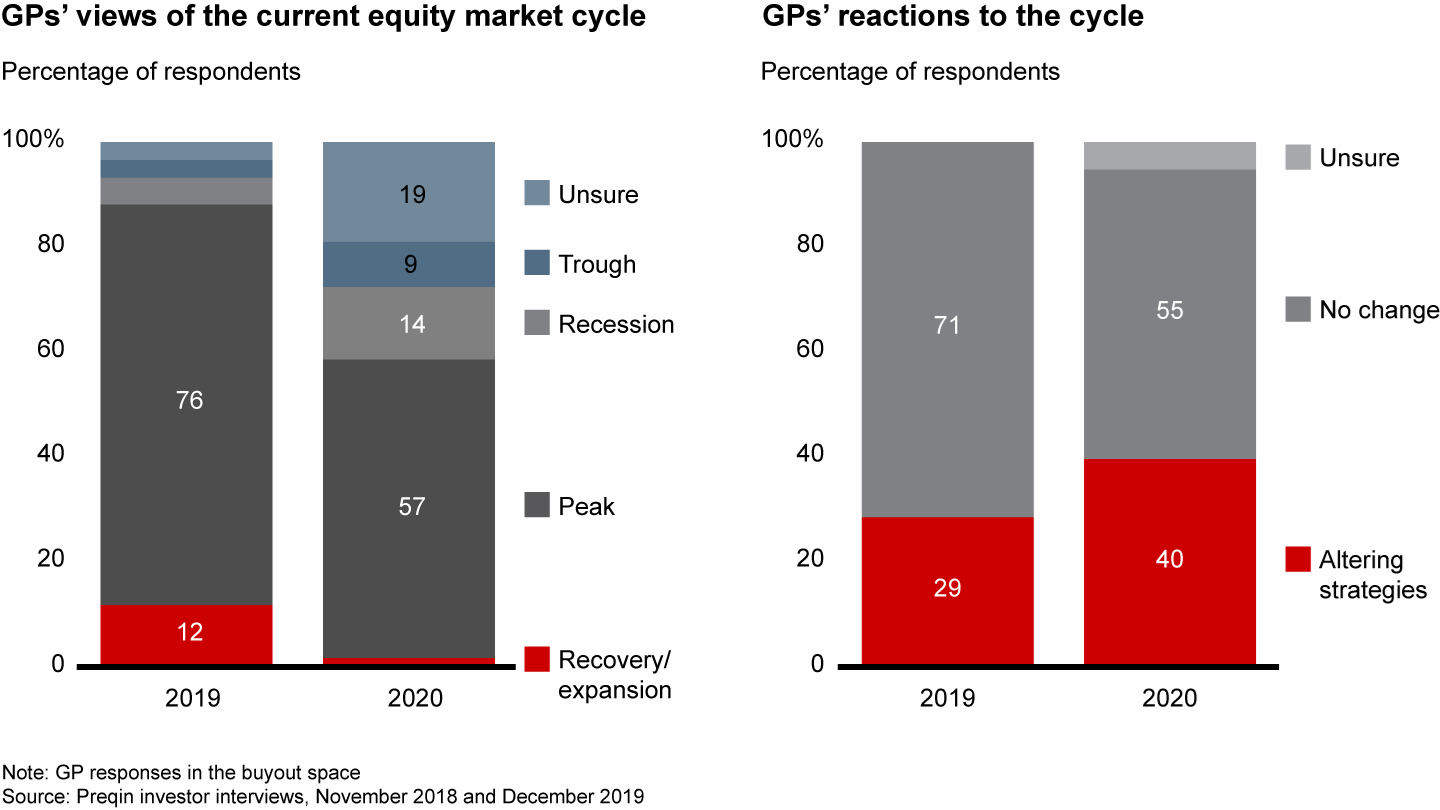
Their caution has merit if the past recession, during which about one-quarter of buyout firms stopped raising capital, serves as any indication (see Figure 1.2). For PE firms, however, the question is less about when the next downturn will come than how to respond when it arrives.
During the last recession, about one-quarter of buyout firms stopped raising capital, with the smallest firms hit the hardest

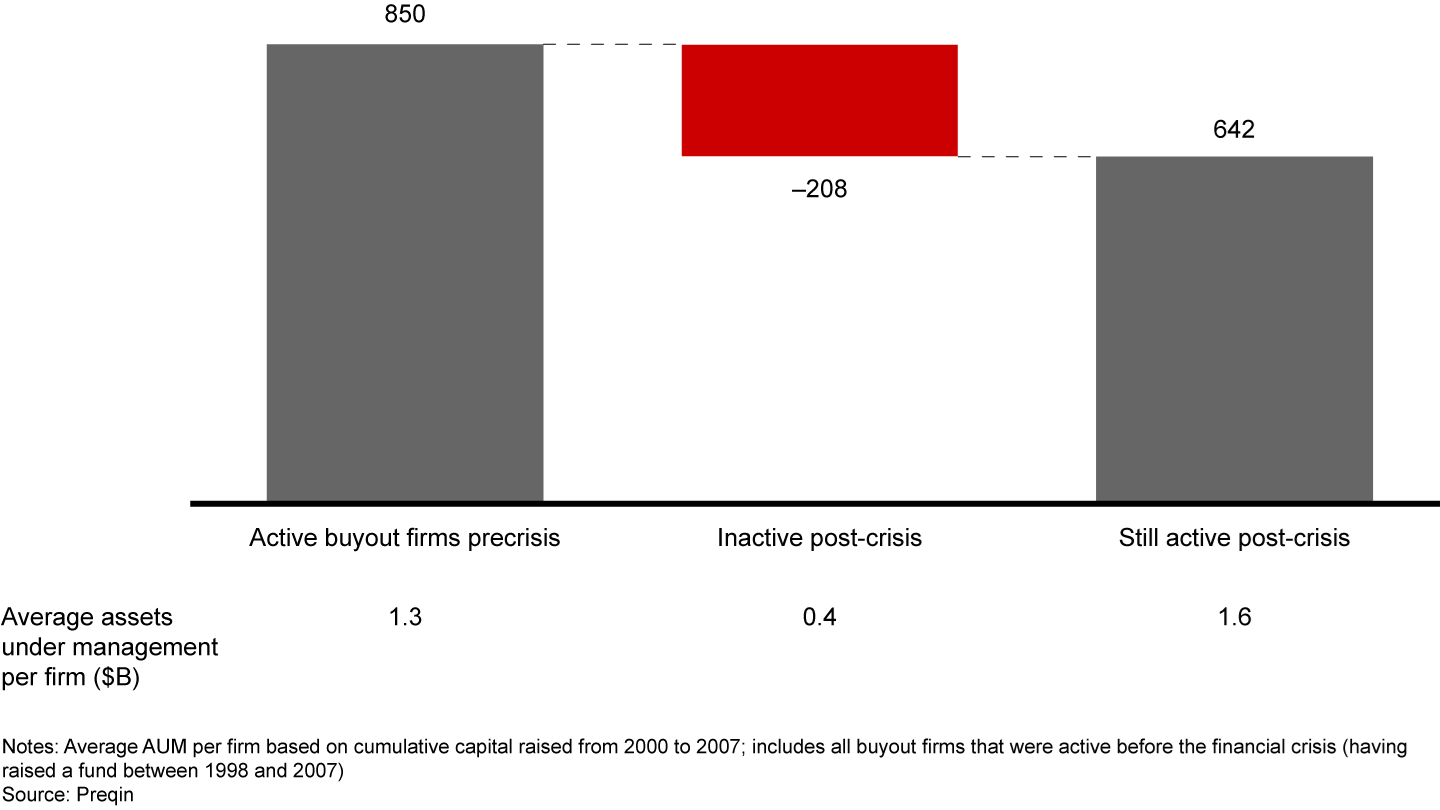
A growing number of GPs have already taken steps to prepare. Roughly 40% of PE funds have altered their investment strategies, with some assessing recession risks more carefully during due diligence. Others are building more balanced portfolios to emphasize countercyclicality, and most are either accelerating exits or getting more wary of overpaying.
Despite the somber macroeconomic outlook, global PE activity did not slow much in 2019. GPs continued to make deals, find exits and raise even more capital than ever (though through fewer funds), fueled by enthusiasm from limited partners (LPs) (see Figure 1.3).
Buyout deals posted another strong year, despite a worsening macroeconomic outlook

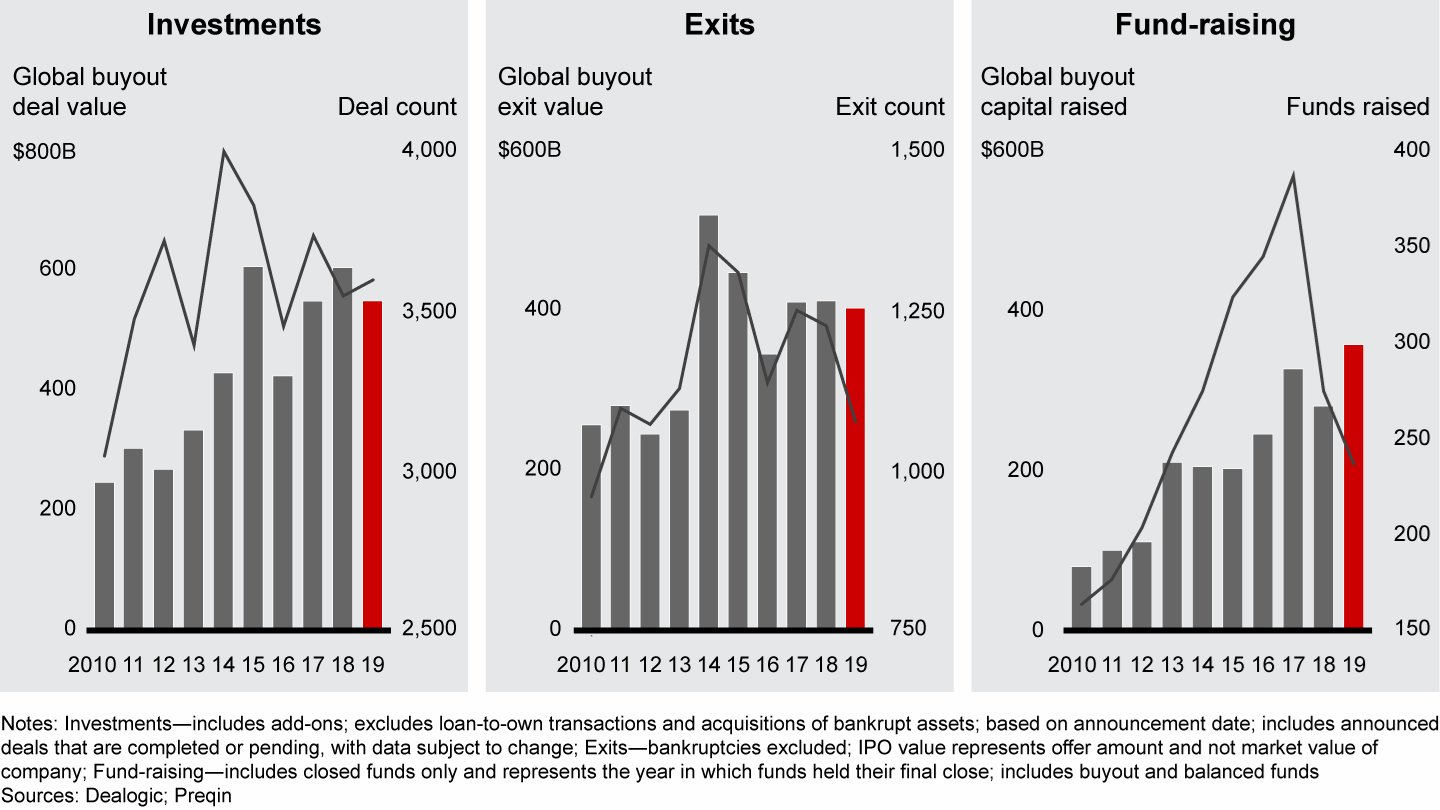
Investments: High prices, higher stakes for value creation
While buyout deal value lagged 2018, it remained on par with the past five years at $551 billion (see Figure 1.4). Amid stiff competition and rising asset prices, GPs closed fewer megadeals. Despite private equity’s remarkable run over the past decade, the industry failed to increase its share of the global market for mergers and acquisitions. Global buyouts represented 13% of M&A deal value in 2019, compared with 15% in the previous two years. The number of buyout deals, meanwhile, remained stubbornly flat at roughly 3,600.
Buyout deal value has been bouncing around since 2015

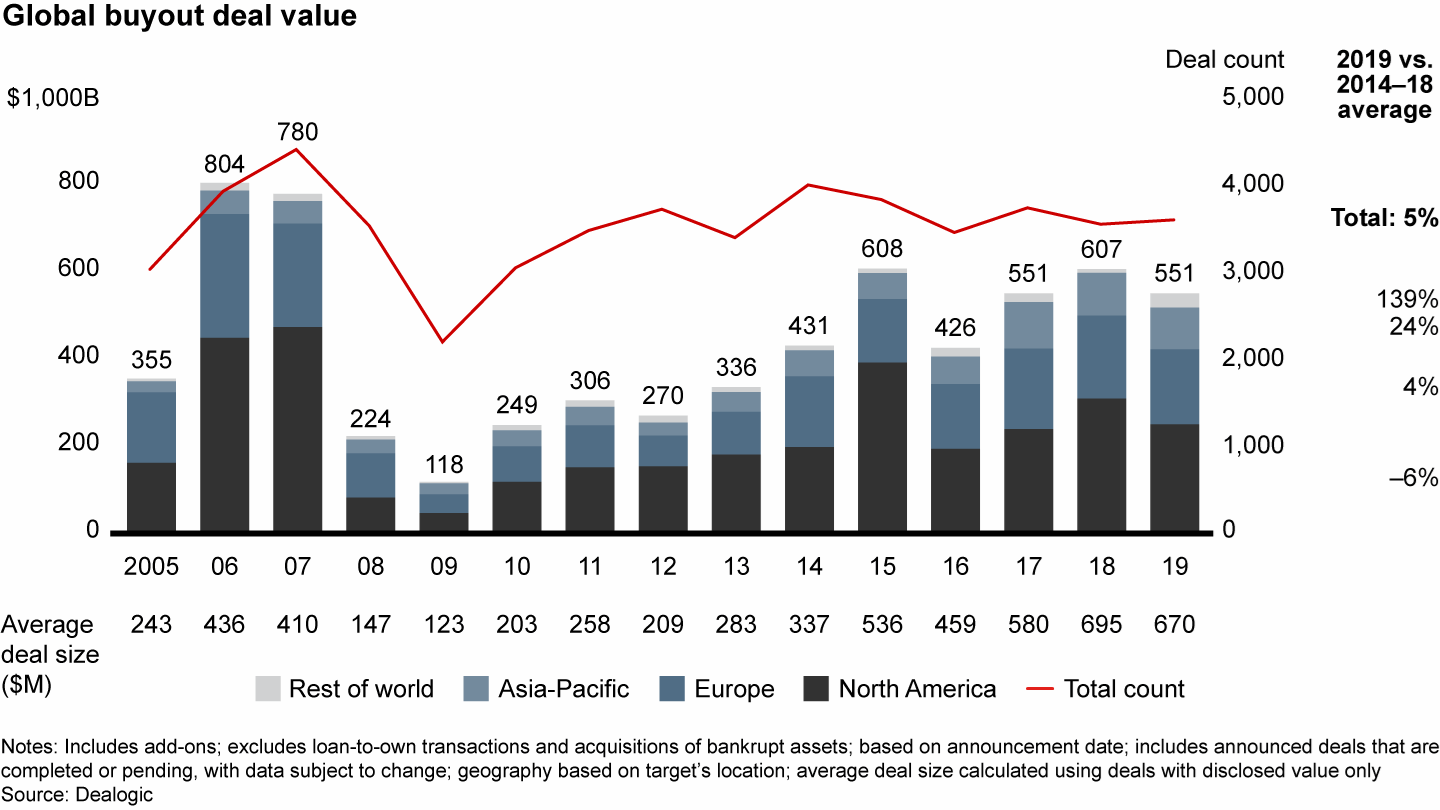
Debt markets encouraged GPs to keep doing deals through much of 2019. So-called covenant-lite loans have remained popular thanks to the more relaxed US regulatory environment, which allowed highly leveraged debt to grow as a share of overall debt. Deals with debt multiples higher than six times earnings before interest, taxes, depreciation and amortization (EBITDA) rose to more than 75% of the total. That comes in stark contrast to the years following the global financial crisis, when their share did not exceed 25% (see Figure 1.5). The true leverage of many deals may be even greater, as banks commonly allow borrowers to calculate multiples based on projected earnings instead of actual results.
A growing share of buyout deals have been highly leveraged with debt

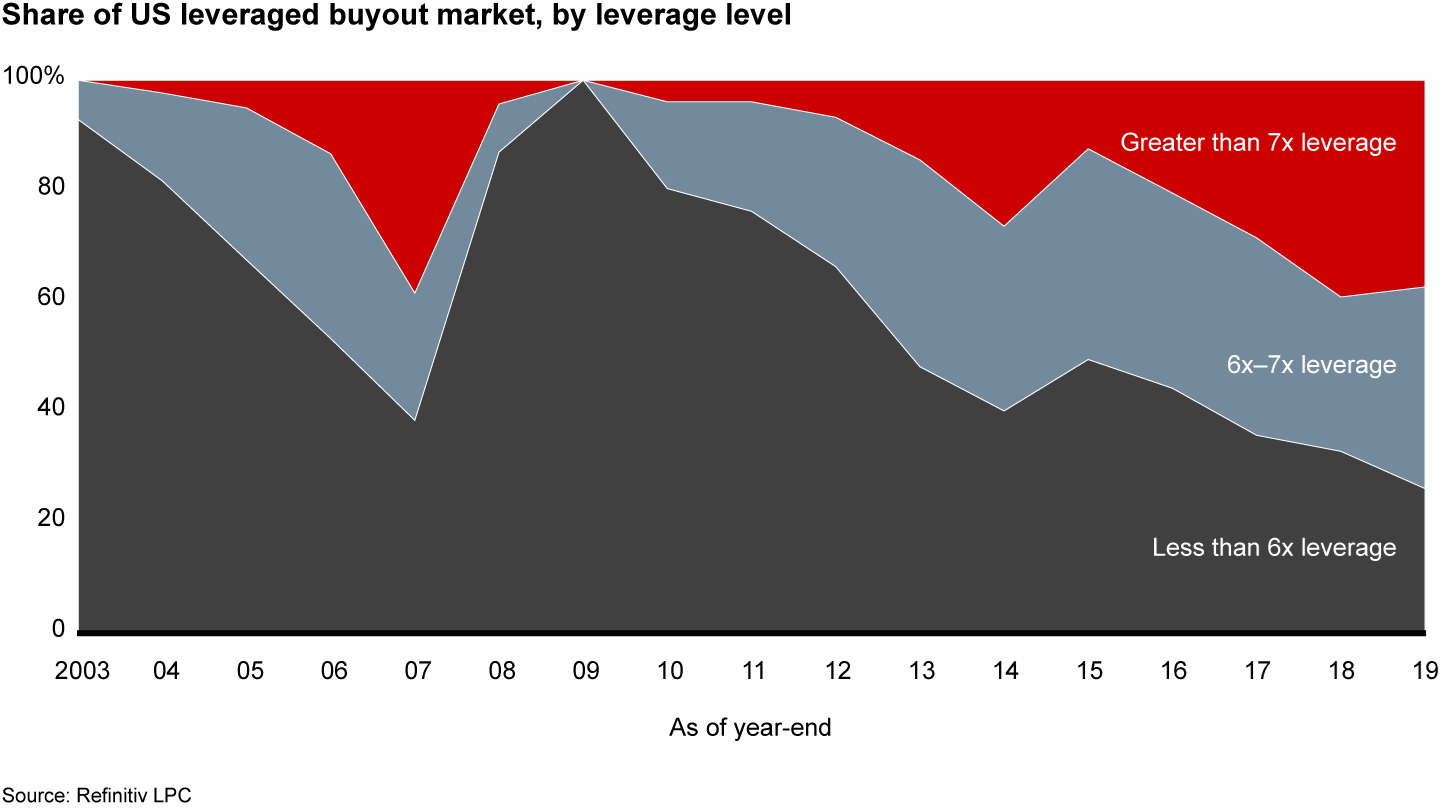
While GPs remained hungry to deploy capital, aggressive corporate buyers and a crowded marketplace pushed asset valuations to record highs during the year. The average multiple of enterprise value (EV) to EBITDA for a leveraged buyout (LBO) reached 11.5x in the US and 10.9x in Europe (see Figure 1.6). Over 55% of US buyout deals in 2019 had an EV/EBITDA purchase price multiple above 11x (see Figure 1.7).
Multiples for leveraged buyouts reached another high in the US but moderated slightly in Europe

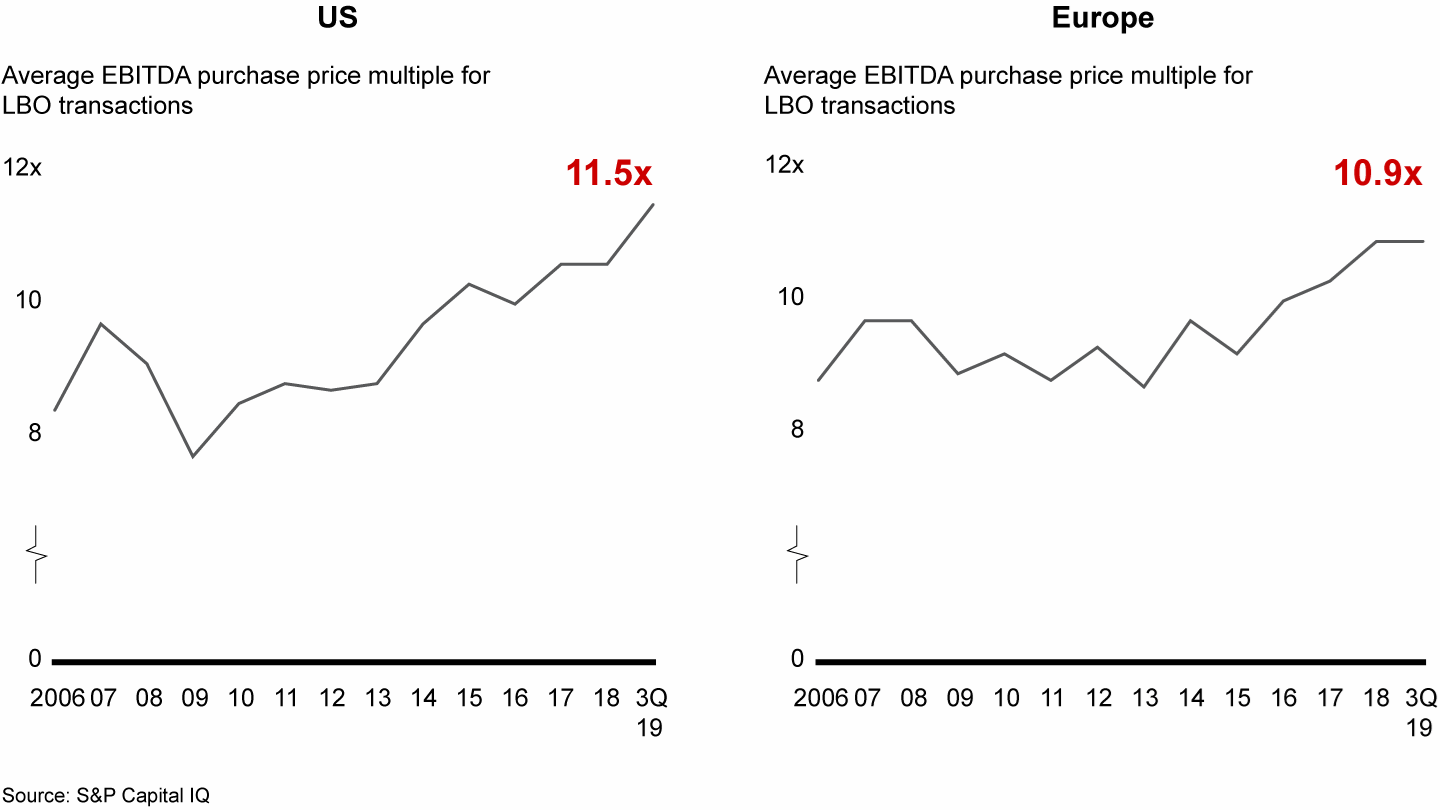
More than 55% of US buyout deals had a multiple above 11x

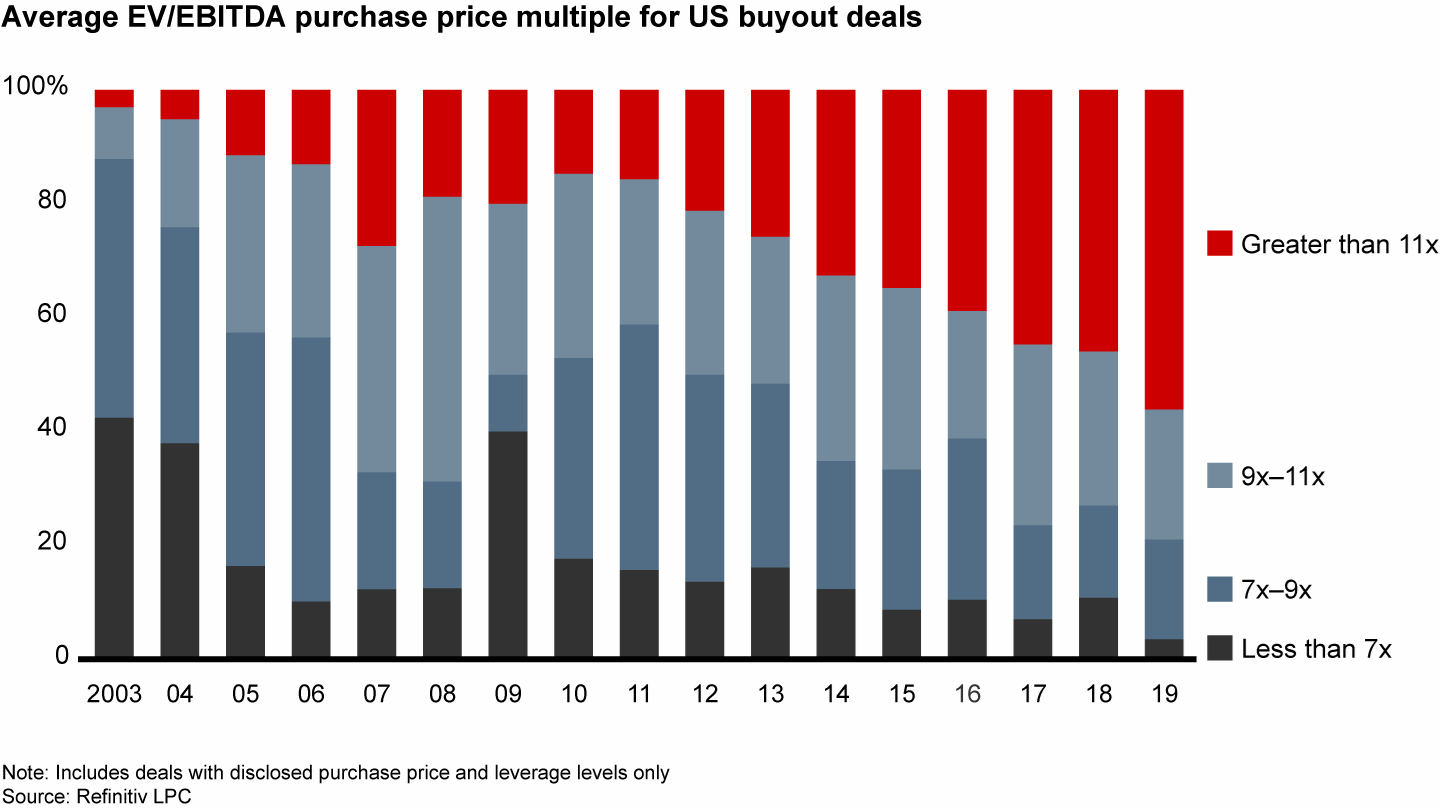
Observers often single out the technology sector in discussing high multiples, and valuations do tend to be higher in tech. However, an analysis of CEPRES data on deals done between 2011 and 2017–18 indicates that sector mix had little to do with the increase. Instead, multiples rose across all sectors (see Figure 1.8).
Buyout multiples have risen across the board, not just in the technology sector

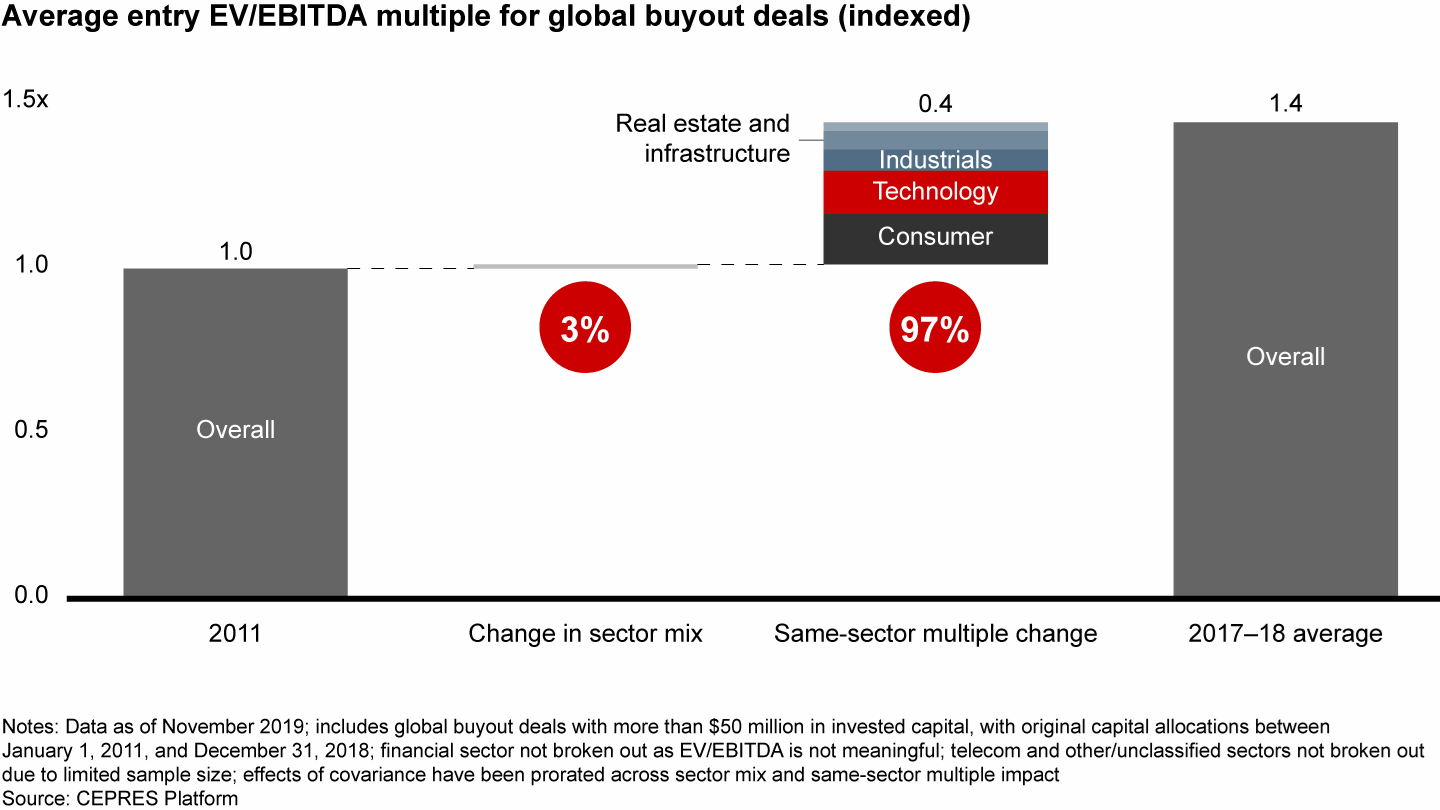
Public-to-private (P2P) transactions continued to propel dealmaking, as funds broaden their hunting grounds. In fact, the number of P2P deals hit its highest level since the previous boom, only 10 short of the 2007 peak (see Figure 1.9). Eight of the year’s top ten buyouts involved public companies taken private, including Zayo Group Holdings, which Digital Colony and EQT bought for $14.3 billion. Mounting fees, paperwork and analyst scrutiny prove too much of a distraction for many public-company executive teams, who feel that going private will make it easier to avoid the quarterly reporting grind and keep their eye on creating long-term value.
The number of public-to-private deals rose, reaching the highest level since 2007

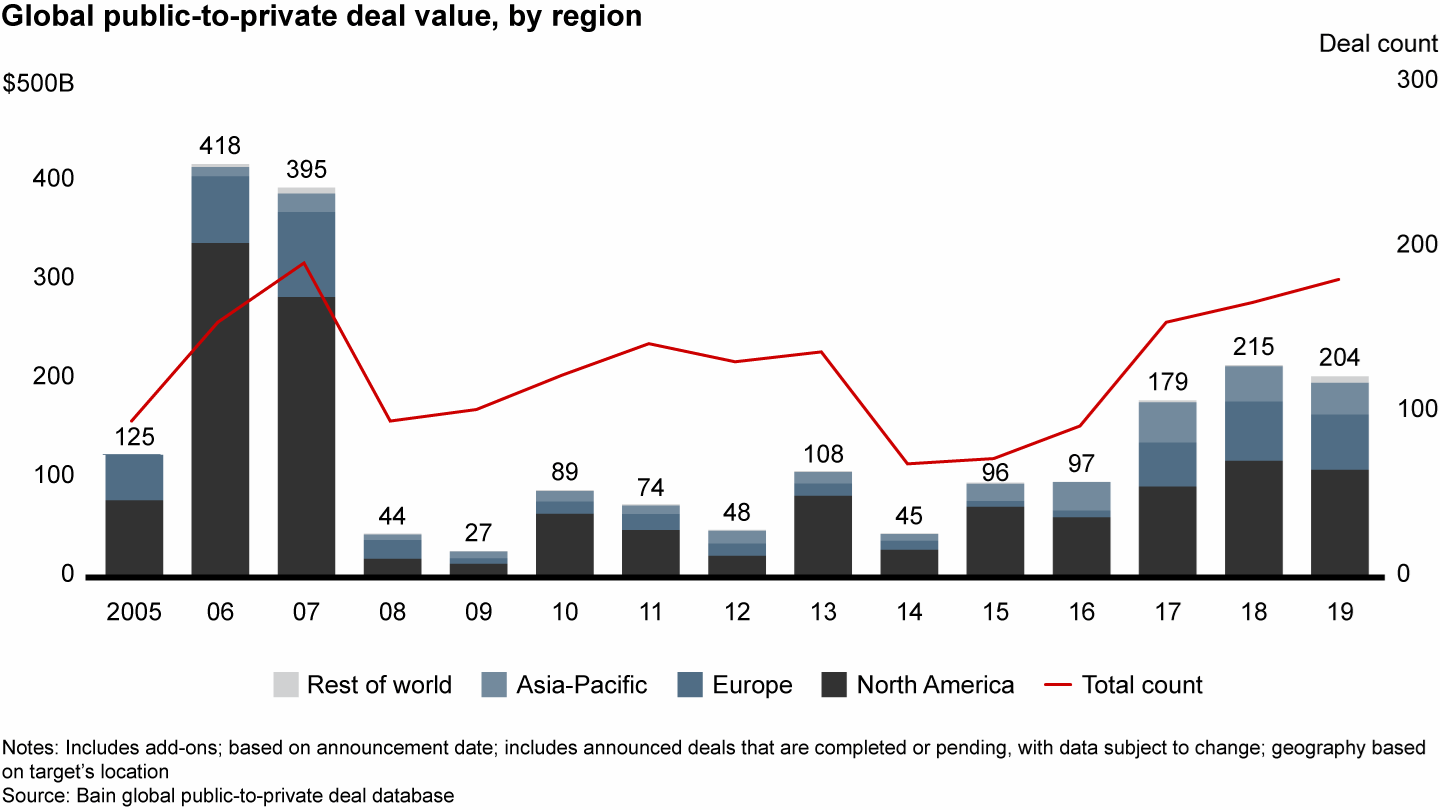
What’s clear is that PE funds are taking an increasingly sophisticated approach to screening public companies. High multiples underscore the importance of having a clear investment thesis for each P2P deal. We see several solid theses that characterize strong candidates for take-private transactions:
- From good to great. PE firms commonly target stable companies that may have a good outlook but also could improve their operational metrics. These companies may be undervalued in the market and can afford to take on debt.
For example, Advanced Computer Software Group, a British cloud software company, had used acquisitions to rapidly increase revenues, but its margins had dropped to 6% in 2014. That year, Vista Equity Partners took the company private for $1.2 billion. Over the next five years, the fund helped transform Advanced operationally by realigning its structure, bringing in new talent, launching new cloud-based solutions and completing six acquisitions. In 2019, Vista sold half of its stake to BC Partners in a deal estimated to be worth $2.4 billion, which would have tripled the enterprise value. - High performance improvement potential. Another common thesis targets public companies with mediocre performance. These firms could significantly improve their cost structure under the right PE ownership and might carry an attractive (though not rock-bottom) valuation.
Atrium Innovations, a Canadian maker of vitamins and supplements, faced slipping profit margins, operational issues in Europe and new pressure to meet regulatory standards when Permira bought it for $1.1 billion in 2014. Permira proceeded to simplify the company’s brands, streamline manufacturing and regulatory compliance, and expand abroad. As a result, both revenues and margins improved. That attracted Nestlé Health Science, which bought Atrium in 2017 for $2.3 billion, a 110% increase in enterprise value.
- Turnaround of a distressed asset. A less common thesis is to look for a firm with an urgent need for capital. These companies may have high turnaround potential but can be bought for a low price.
That was the investment thesis of Baring Private Equity Asia when it decided in early 2019 to acquire Pioneer, a cash-strapped Japanese maker of car navigation systems, for $900 million, representing an EV/EBITDA multiple of 5x.
- Portfolio breakup. Conglomerates with high potential for performance improvement may also come under pressure to divest assets or entire business units. These assets make attractive targets for PE firms to turn private.
This is what Blackstone bet on when it bought back UK-based Serco Global’s business process outsourcing operations in 2015, in a $385 million deal, and formed Intelenet Global Services, headquartered in India. (Blackstone had previously acquired a stake in 2007 before selling to Serco in 2011.) In 2018, French outsourcing giant Teleperformance acquired the company in a $1 billion deal, representing a 2.6x increase in enterprise value.
Why cosponsorship has taken off
To satisfy their appetite for private equity investments and enhance their returns, LPs are increasingly willing to cosponsor deals with GPs. Based on a sample of the most active institutional investors, cosponsored deals set a new record in 2019, reaching 10% of the buyout market’s total value (see Figure 1.10).
Deal cosponsorship between general partners and limited partners is on the rise


Over time, LPs have targeted larger deals, and average deal value reached $5.2 billion in 2019, vs. about $4 billion for the past five years. It’s now common for institutional investors to cosponsor more than 10% of a deal’s value.
For the LPs most active in cosponsorship, such as CPPIB, CDPQ and GIC, the arrangement usually offers lower fees and thus better returns. They also accelerate their capital deployment in private equity, a clear benefit given that about half of institutional investors were underallocated to the asset class heading into 2020 (see Figure 1.11). Because cosponsorship does not require LPs to get involved in deal sourcing or due diligence, it appeals to a larger set of investors.
About half of limited partners are underallocated in private equity

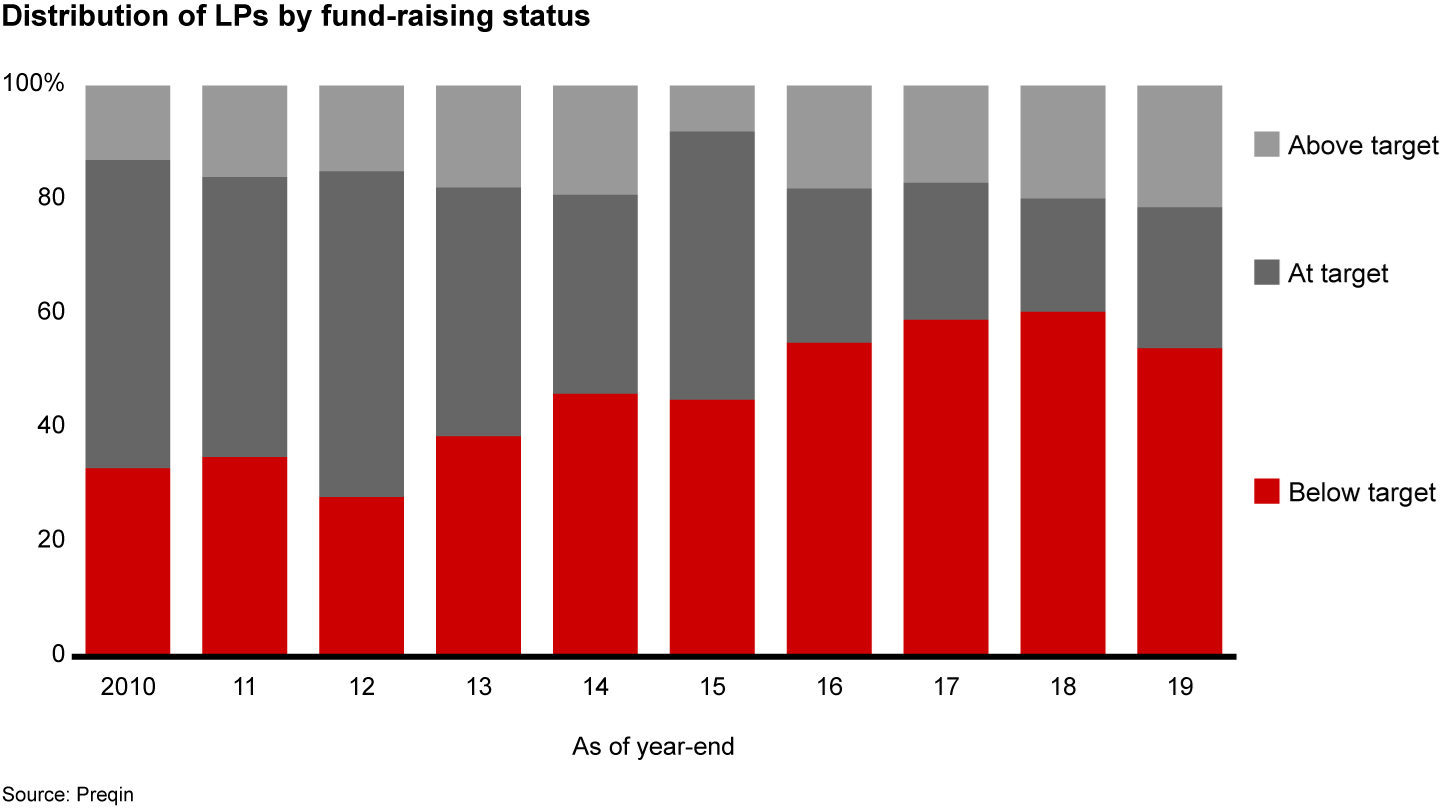
The benefits for GPs are less clear. Although it can slow down the process or create additional costs, more than 45% of GPs plan to offer more coinvestment opportunities in 2020. Their rationale for doing so is to access larger deals, or to deepen their relationships with select institutional investors. Funds such as Blackstone, EQT and BC Partners have decided to adopt consistent strategies for partnering with LPs.
As the cosponsorship trend illustrates, GPs and LPs are searching for good deals far and wide to put their vast stores of capital to work. Despite the strong pace of investment since 2014, PE dry powder, or uncalled capital, has been rising since 2012. Dry powder hit a record high of $2.5 trillion in December 2019 across all fund types and more than $830 billion for buyouts alone (see Figure 1.12). More than half of it sits in North America.
Dry powder has been piling up globally

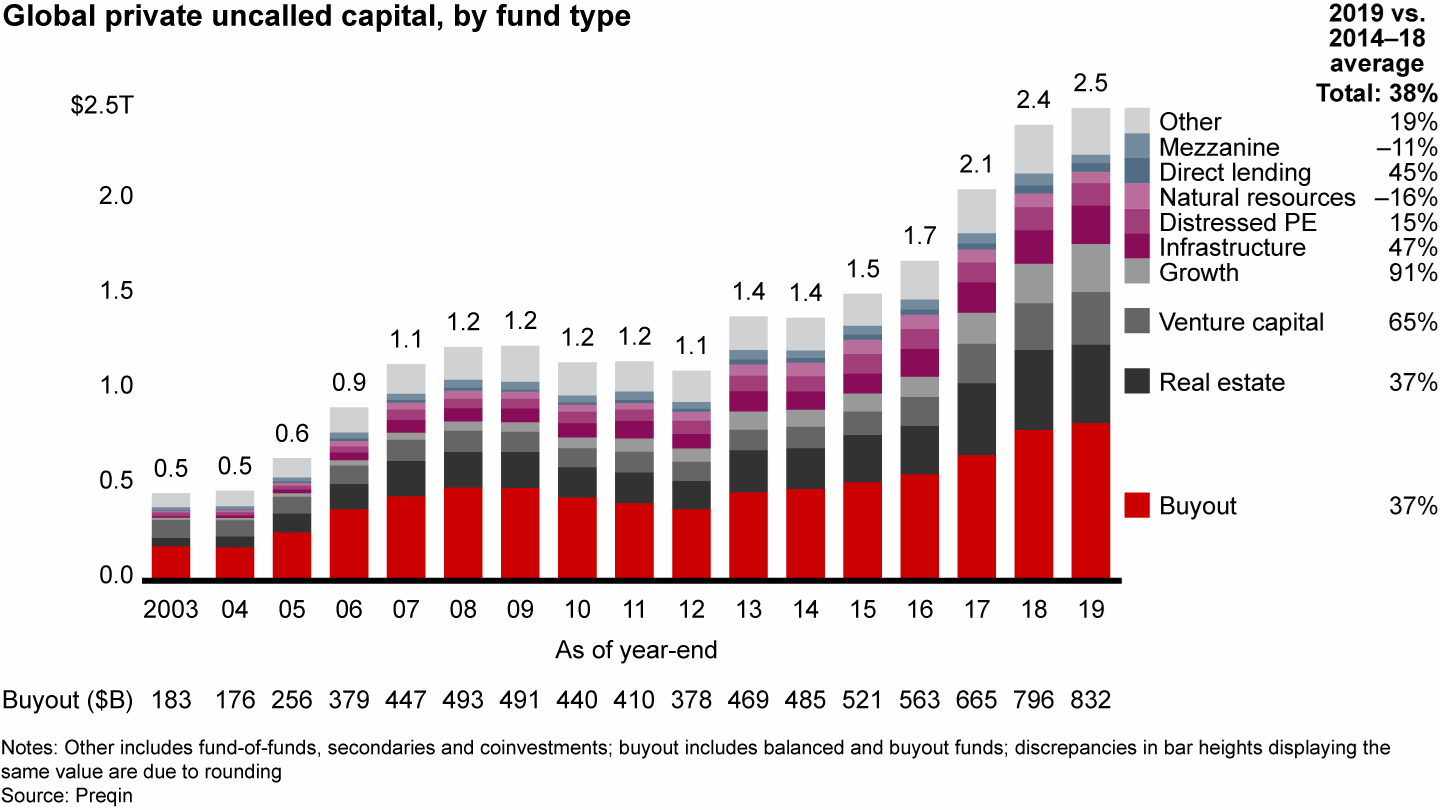
Some observers have raised concerns about the stockpile, suggesting that if a recession hits, GPs could be left holding many years of uncalled capital and would seek extensions.
We take a more sanguine view. Based on current deal values, the dry powder held in buyout funds today represents about 2.6 years of future investment, far below the approximately 4.5 years of 2007 and 2008 (see Figure 1.13). Even for smaller funds, “old” capital (2015 or earlier) constitutes less than one-fifth of what they have to put to work. It helps that PE firms are accumulating mostly “young” capital, raised by funds with recent vintages.
The average time to use buyout dry powder has fallen to levels well below the stockpile just before the financial crisis

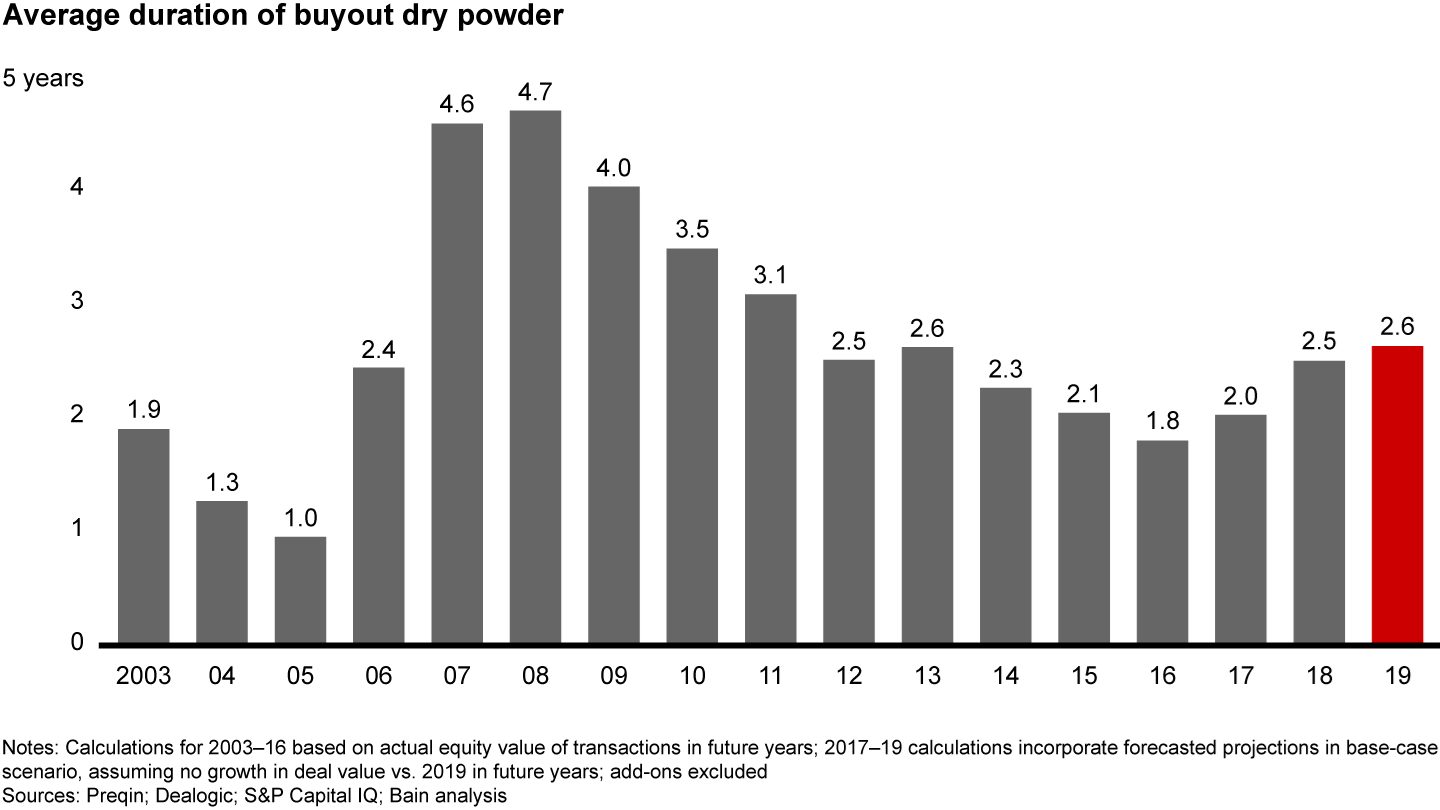
Buyout firms hold more than two-thirds of their dry powder in funds raised in the last two years, meaning that the recent deal cycle is clearing out the older capital and replacing it with new (see Figure 1.14).
Buyout dry powder is not getting any older

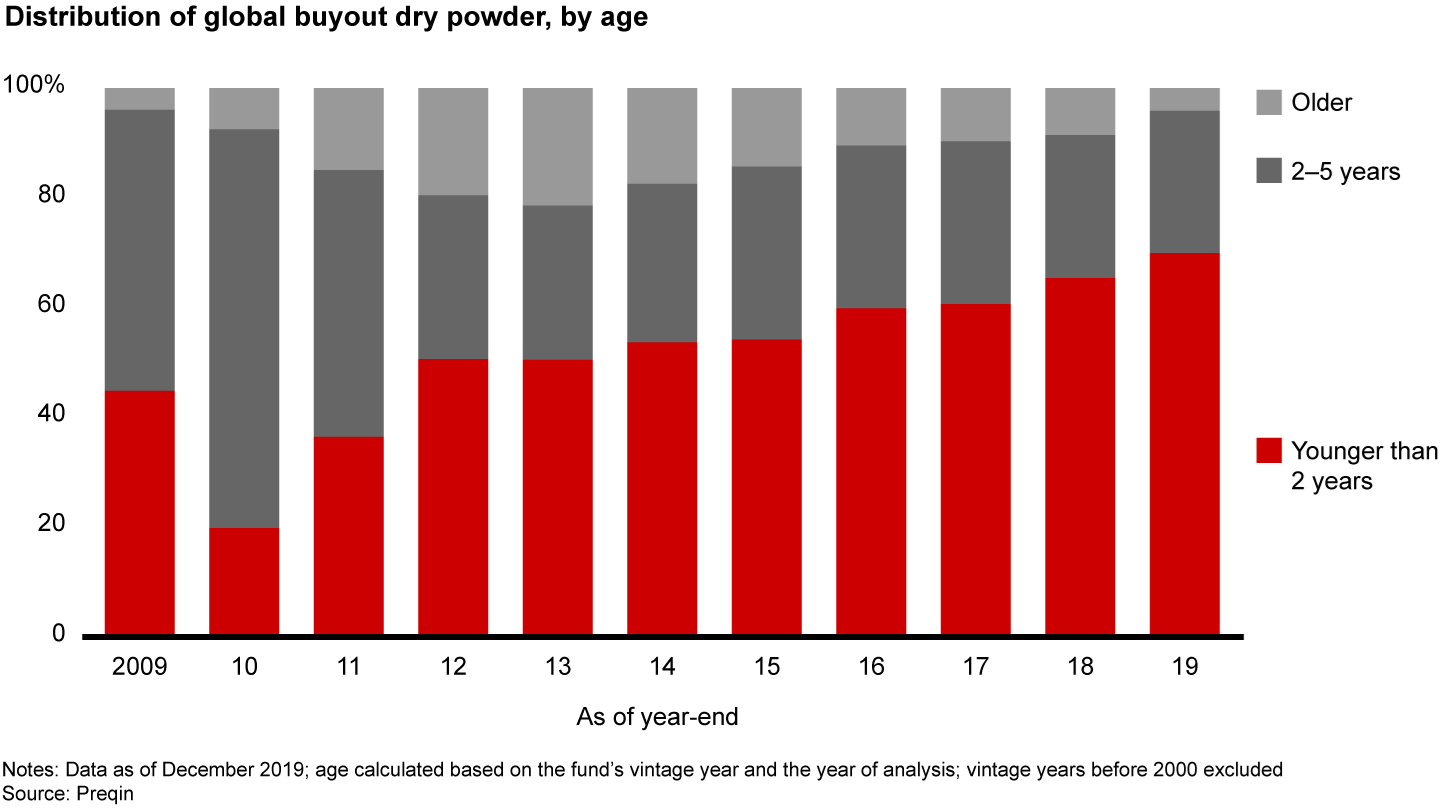
The combination of abundant capital on easy terms, rising asset prices and a more negative economic outlook has prompted many GPs to take a more cautious stance. Leading firms are adjusting their approaches to avoid overpaying and to prepare for a possible downturn.
As we explore in Section 2, the most effective firms are taking pains to spot disruption early. They find creative paths to monetize innovation in sectors such as technology or payments. They turn to tactical levers such as pricing in order to create value faster. GPs also increasingly consider environmental, social and governance issues in their decisions, which means looking for deals with positive impact beyond the financial returns. Firms continue to put money to work, but now they must work harder to reap the benefits.
Exits: A return to shorter holding periods
Exit value ticked slightly lower in 2019, to $405 billion, continuing a six-year stretch of very strong distributions for investors (see Figure 1.15).
The favorable environment for exits persisted in 2019

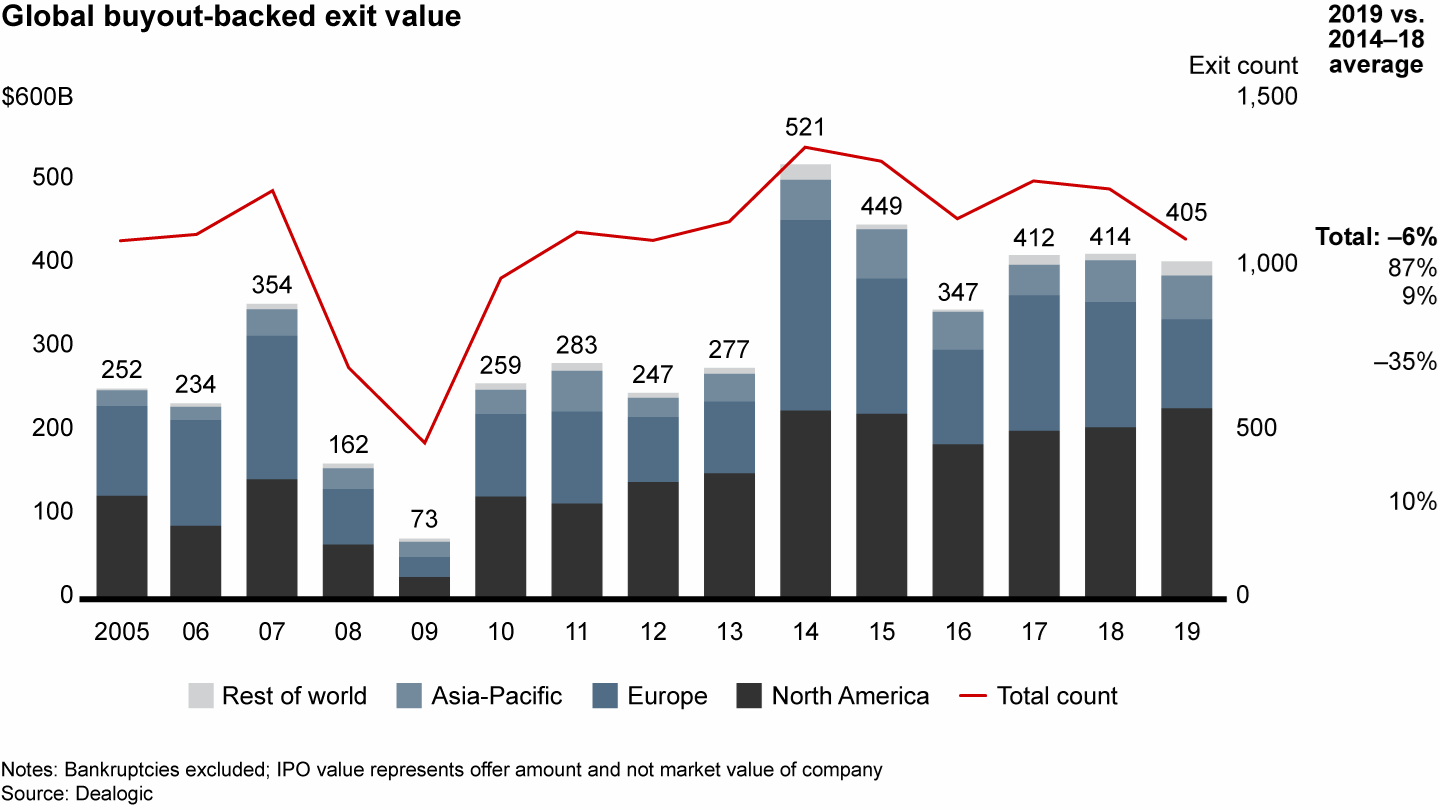
It was a different story for volume, with exit count down to 1,078, its lowest level since 2012. Activity in Europe dropped along with dealmaking generally, due to economic malaise in the southern tier and Germany, plus a Brexit-induced holding pattern.
With exit value high, investors were cash flow positive for the ninth year running, meaning distributions have outstripped contributions each year. For the first half of 2019, however, strong fund-raising demands meant that capital returned was barely higher than capital called (see Figure 1.16).
Limited partners have been cash flow positive on their PE investments for nine years running

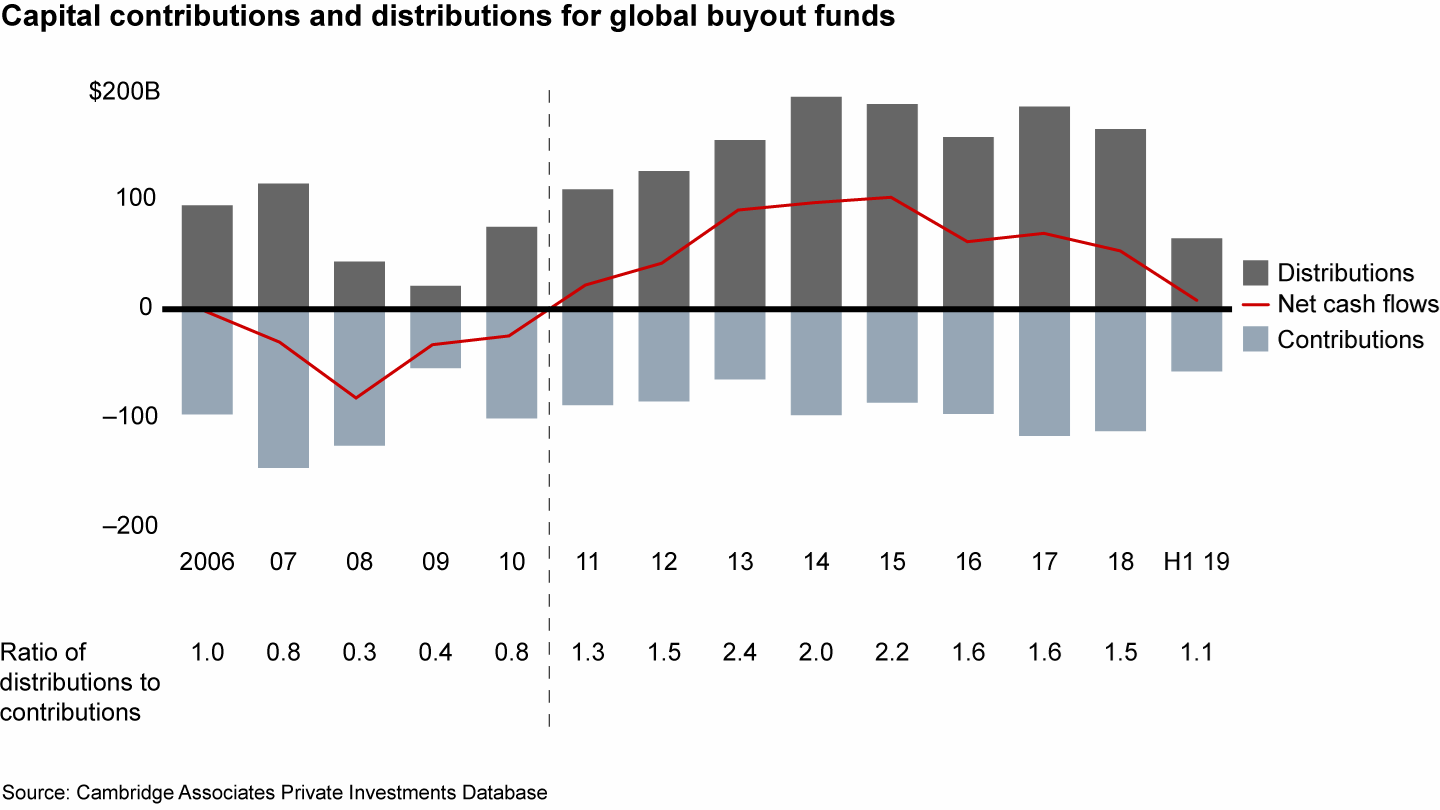
We have seen the hangover of long holding periods (how long funds hold portfolio companies before exiting) on poorly performing assets from the recession. Now portfolios have returned to healthier post-recession holding periods. The median holding period across all exits fell to 4.3 years in 2019, well below the 6.0 years in 2014 (see Figure 1.17). Anyone who had a good asset has likely sold it, partly due to premium prices and partly in anticipation of a recession, when it could be harder to sell.
Holding periods have fallen as general partners exit more of their companies in less than five years

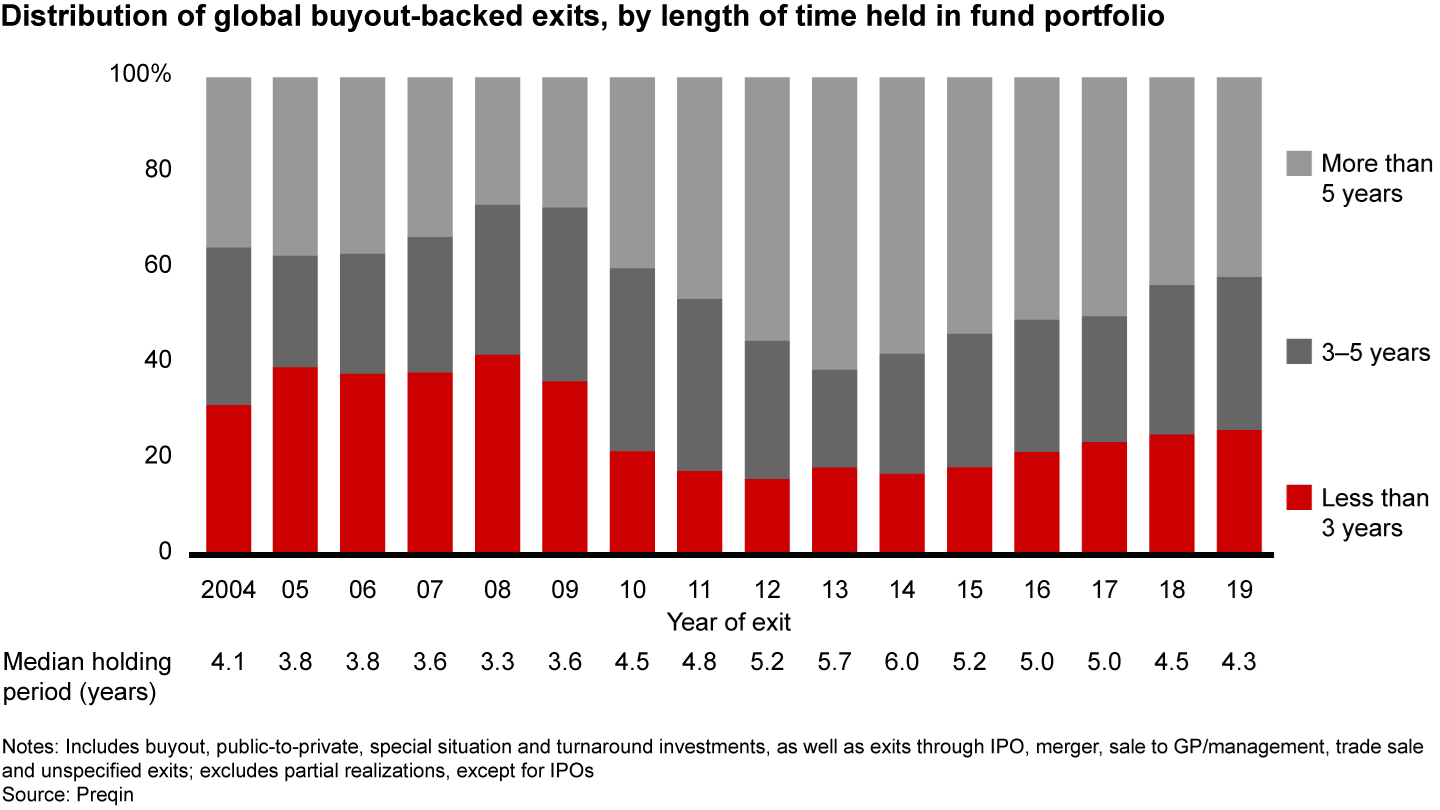
The channel dynamics of exits did not shift drastically in 2019 (see Figure 1.18).
IPOs were down, while sponsor-to-sponsor deals and sales to strategic buyers kept pace

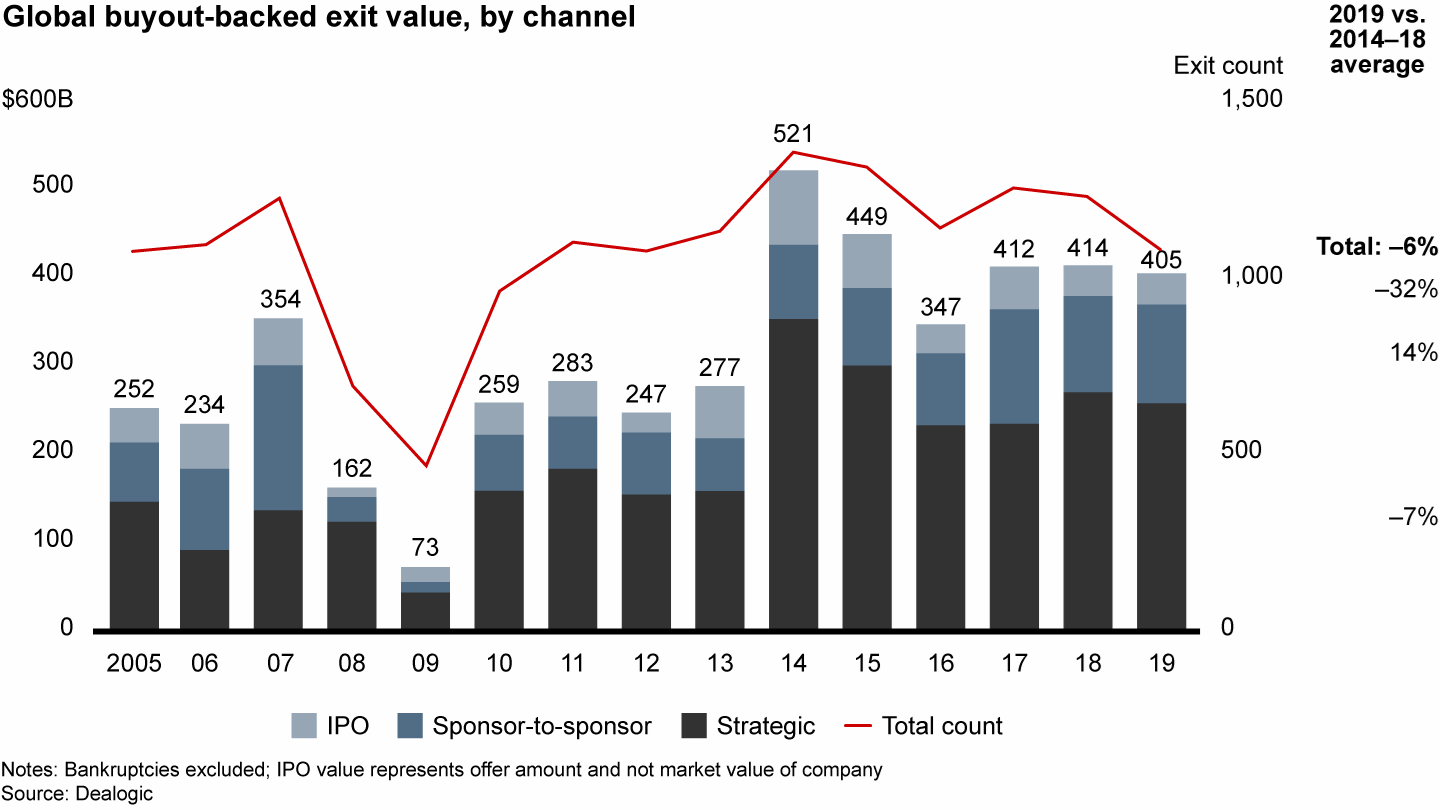
Strategic sales. Exits to strategic buyers remained the biggest channel, maintaining about a two-thirds share of buyout exit value. In line with the solid M&A market in 2019, and despite the challenging macroeconomic context, corporations actively sought acquisitions in order to build scale or add new products or geographies. If anything, corporate buyers have become more sophisticated in how they approach M&A, increasingly targeting smaller companies as candidates for purchase.
Sponsor-to-sponsor exits. Sponsor-to-sponsor deals remained strong in 2019, especially for European companies. The share of these exits was just below 30% globally.
Dividend recapitalizations. GPs take money off the table and derisk investments by recapitalizing debt. But dividend recaps slowed in the US, where leveraged buyout loan rates have continued to increase over the past two years, despite the Federal Reserve’s rate reductions.
Initial public offerings (IPOs). When the economic outlook is uncertain, PE firms prefer strategic exits to IPOs, because they can cleanly sell their entire stake in the asset. It takes months to years before PE funds can fully exit an investment via an IPO, given lockups that restrict how much and how quickly they can sell. So it’s not surprising that IPO exit count dwindled again in 2019, reaching a 10-year low.
That’s consistent with a broader trend. Over the past 20 years, private equity capital has grown at four times the rate of public capital globally, with no slowdown in sight. In the US, the number of IPOs has fallen since the mid-1990s.
For IPO deals involving private equity, funds typically retain a stake in the newly public company, so post-IPO performance is critical. Yet the results are mixed. New Bain & Company analysis shows that two-thirds of 981 global IPOs (including corporate-led IPOs) underperformed over the following five years against relevant public benchmarks.
IPOs led by PE funds did not perform any better than the market in aggregate. More than 70% of the 90 IPOs led by GPs underperformed, averaging an annualized total shareholder return (TSR) that was 12 percentage points lower than the relevant public benchmark. PE funds with more IPO experience tend to have better returns than those with scant experience, though that average masks a large spread (see Figure 1.19).
More than 70% of IPOs led by PE funds have significantly underperformed their benchmark public indexes, but there is a large spread


The elite PE firms that manage to outperform after an IPO do several things differently, our analysis shows:
- They view the IPO as a beginning and a means to longer-term value creation, rather than as any kind of end in itself.
- They understand that post-IPO investors have fundamentally different objectives and incentives than earlier investors, and they double down on communication to ensure their value-creation story will resonate.
- They don’t just seek technical capabilities to prepare for the launch; they also emphasize strategic support that will help create lasting value. They typically target investors oriented toward long-term growth, as opposed to short-term hedge funds. And they prepare for alternative scenarios if the IPO timing or route fails.
Consider the IPO history of NXP Semiconductors. When NXP split from Philips in 2006, it was suffering from heavy losses, lack of strategic direction, high costs and organizational complexity. Once the company stood alone, senior management began a restructuring program to streamline the organization in order to boost productivity and speed. The business also executed a major operational turnaround, resulting in a drastic reduction to the cost base. These moves set up an IPO in 2010, which helped pay down debt. The compelling story for investors included a strategy shift to focus on less-capital-intensive manufacturing, complex segments where it had an R&D advantage and high-growth markets, while shedding noncore businesses.
Post-IPO, NXP continued the restructuring. Timing helped, as 2010 was the first year of recovery for IPOs more broadly. Outsize earnings growth combined with burgeoning segments for future growth appealed to investors, and the share price grew sevenfold over the five-year period in our analysis.
Pinnacle Foods, a US maker of food staples, took a different route to IPO success. Blackstone bought Pinnacle in 2007 and took it public in 2013, a strong period for IPOs. Pinnacle’s stable cash flows attracted unusual demand among investors. But the equity story included other components as well. Under Blackstone, Pinnacle set a productivity initiative that generated annual savings of 3%‒4% in procurement, manufacturing and logistics. The company used its foundation brands as cash cows to fund the growth of leadership brands. Pinnacle also paid an annual dividend of 3%‒4%.
The next five years saw the stock increase steadily as Pinnacle’s well-known brands rode the tailwinds in the frozen food and snack categories. In 2018, when Conagra decided to buy Pinnacle to complement its existing food portfolio, the company had realized a fivefold increase in value.
Fund-raising: Winner take all
Demand for alternative assets in general, and buyouts in particular, remains very strong, with LPs eager to put more capital into the industry. The past year was one of the biggest ever for fund-raising. Investors poured $894 billion into private capital, which includes private equity, real estate, infrastructure and natural resources. The buyout asset class alone raised $361 billion—the largest amount on record—and increased its share to 40% of total private capital, the highest level since 2006 (see Figure 1.20).
Investors continued to pump more capital into alternative asset classes, with buyouts gaining share

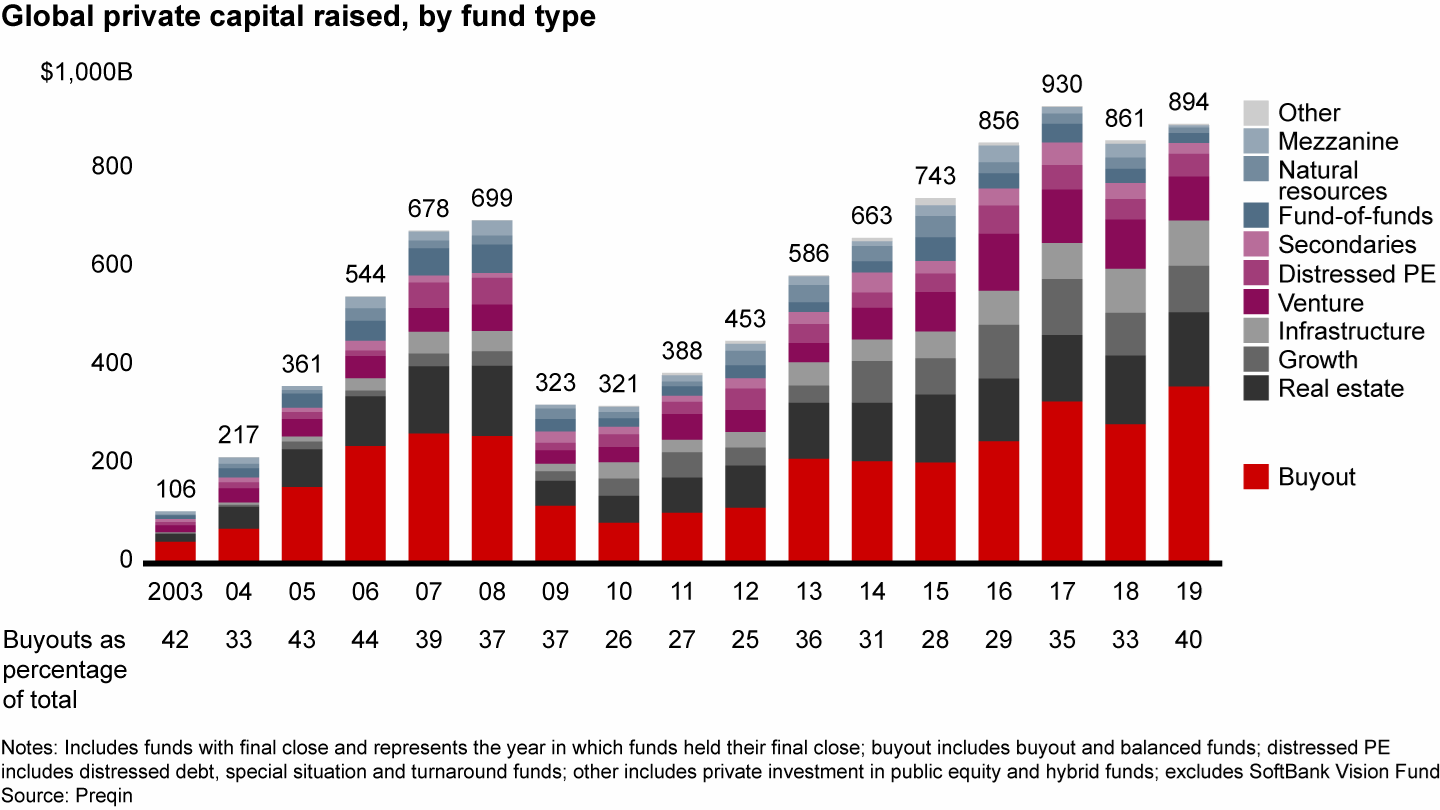
Fund-raising for North American and multiregional funds was particularly strong in 2019, offsetting a decline in Asia.
Almost 70% of buyout funds reached their targets in less than 12 months, and the average time for GPs to close was 10.5 months, nearly 4 months ahead of private capital funds overall (see Figure 1.21).
Almost 70% of buyout funds reached their capital target in less than 12 months

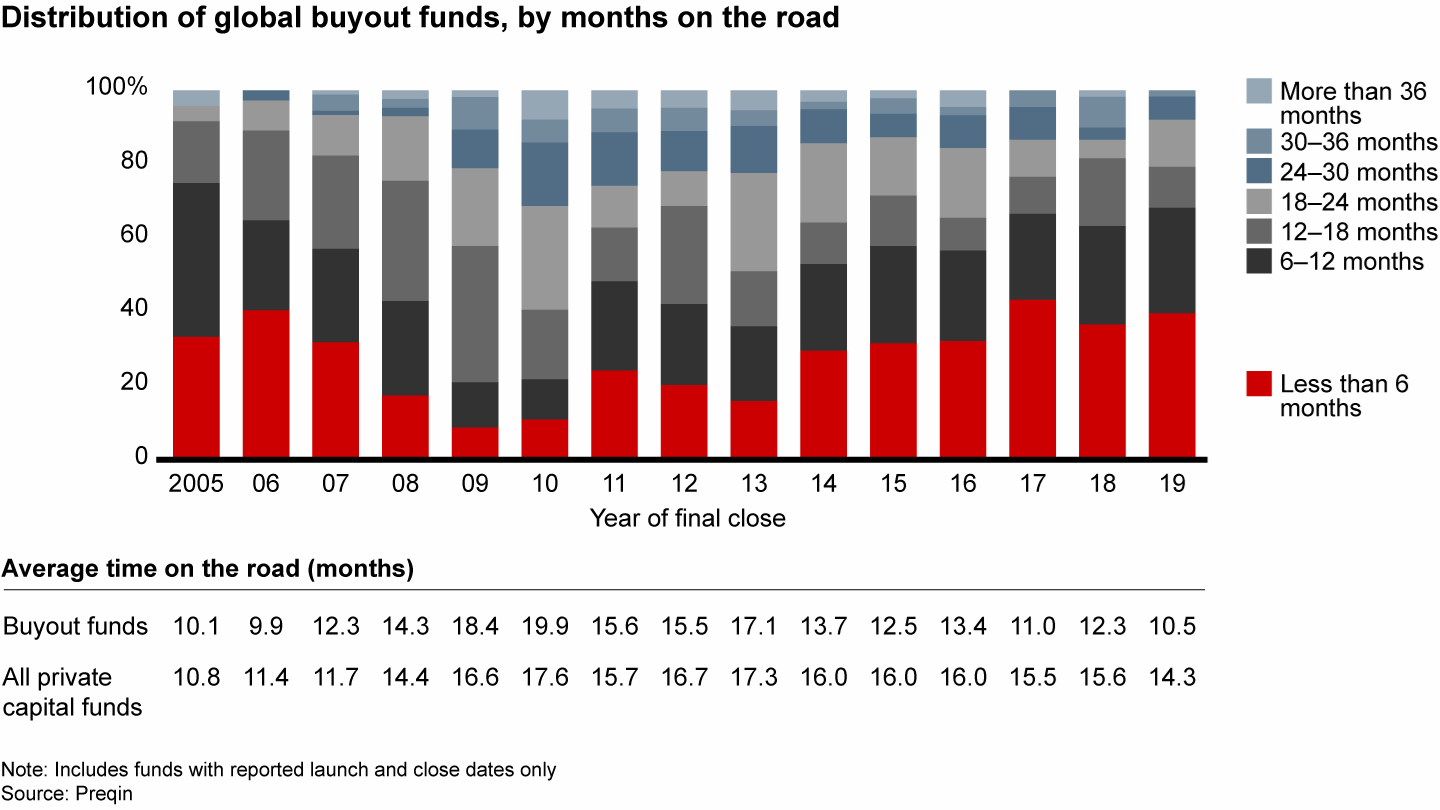
Responding to brisk demand, buyout firms continued to expand their slate of fund offerings. In part, they have moved into other asset classes, and more recently, they have raised successor buyout funds faster (see Figure 1.22).
Buyout firms continue to manage more funds, expanding to new asset classes and launching successor funds faster

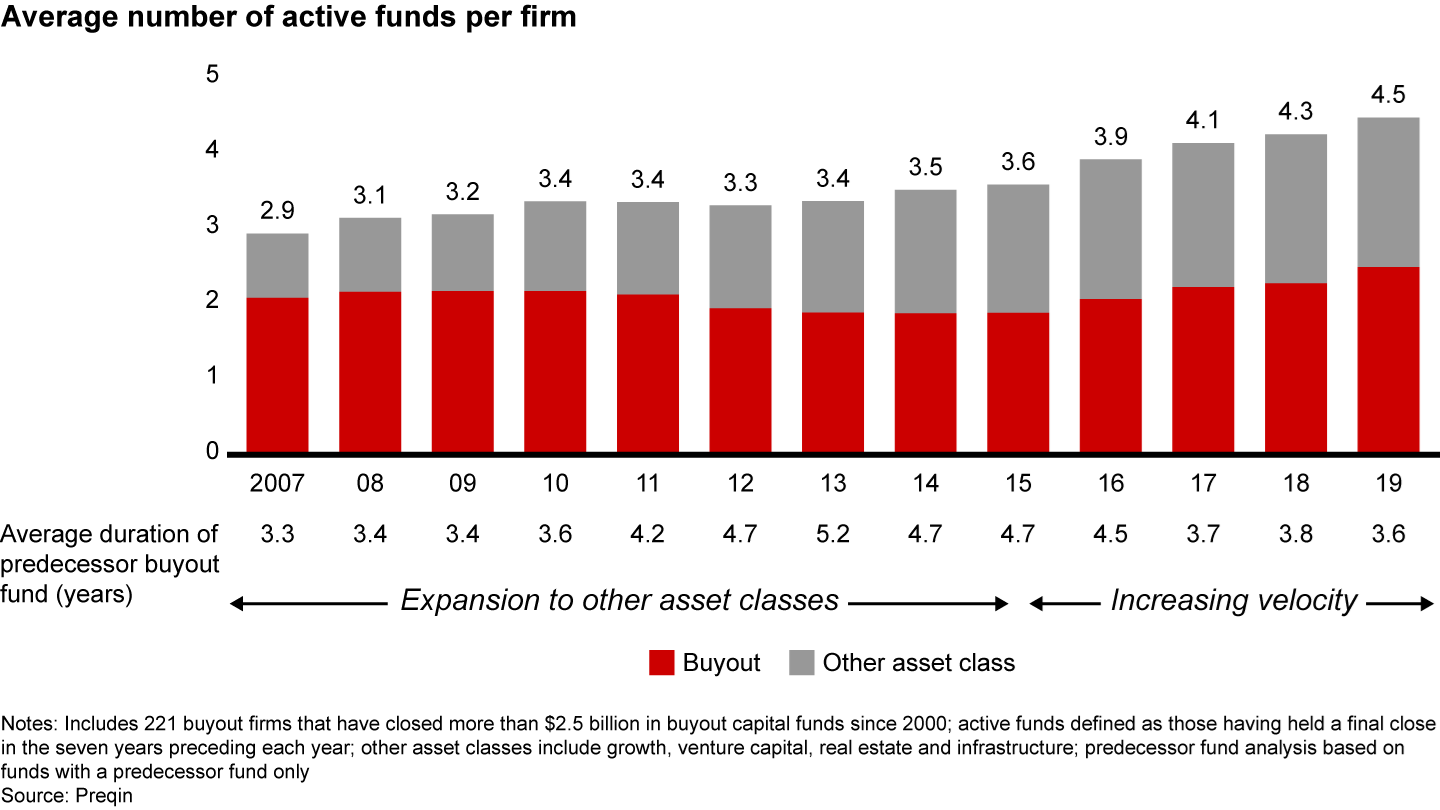
One trend became evident last year—namely, that more of the capital flowed to fewer firms (see Figure 1.23).
In fund-raising, more capital is going to fewer firms

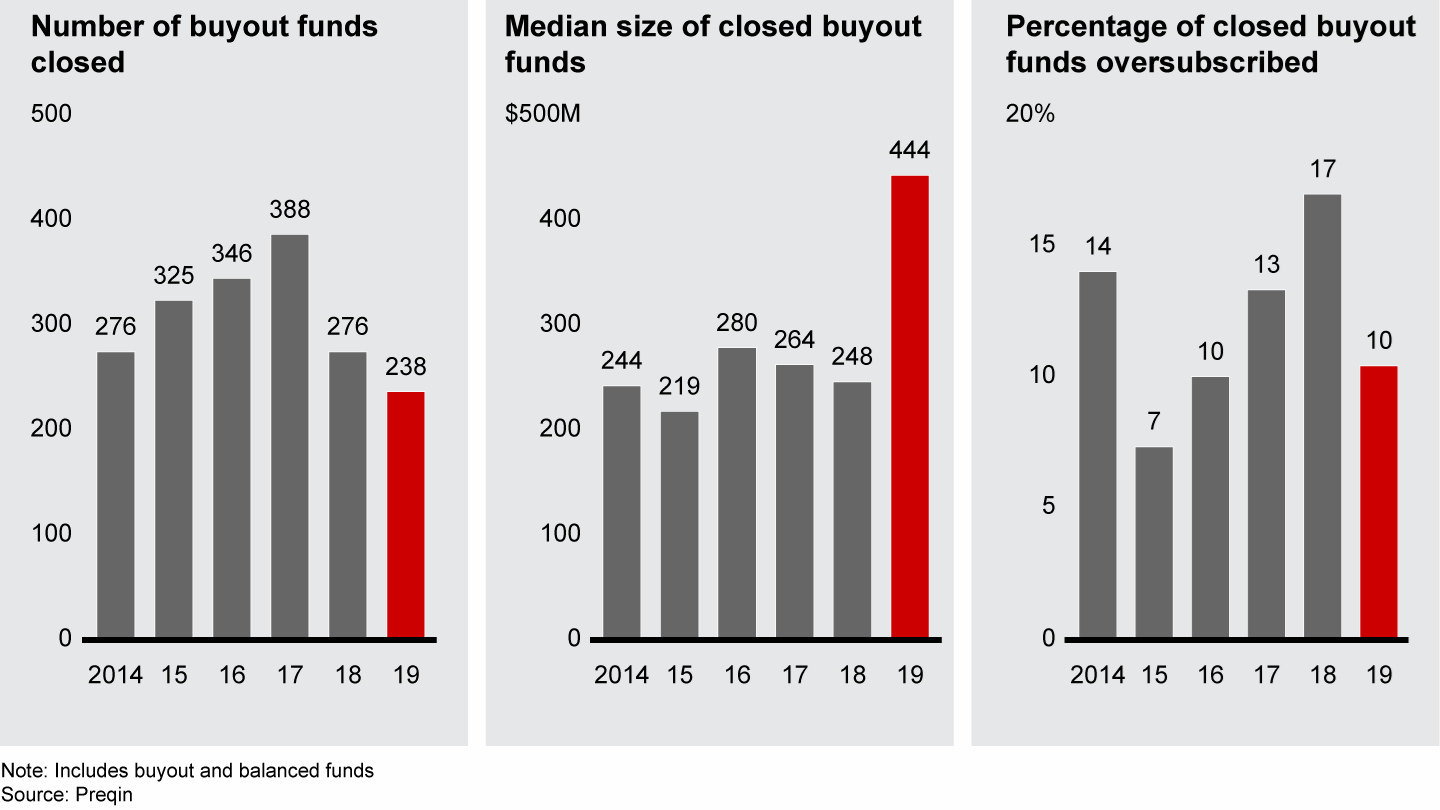
We analyzed 220 buyout firms that each had raised more than $2.5 billion since 2000, comparing the 2013–19 cycle with 2006–12. We defined winning firms as those that outperformed the average growth rate of 50% by 40%—in other words, the value of the funds they raised in 2013–19 was at least 70% higher than what they closed in 2006–12. By contrast, losing firms underperformed the average by 40% or more (see Figure 1.24).
A comparison of capital raised during this cycle and the previous one reveals winning and losing patterns

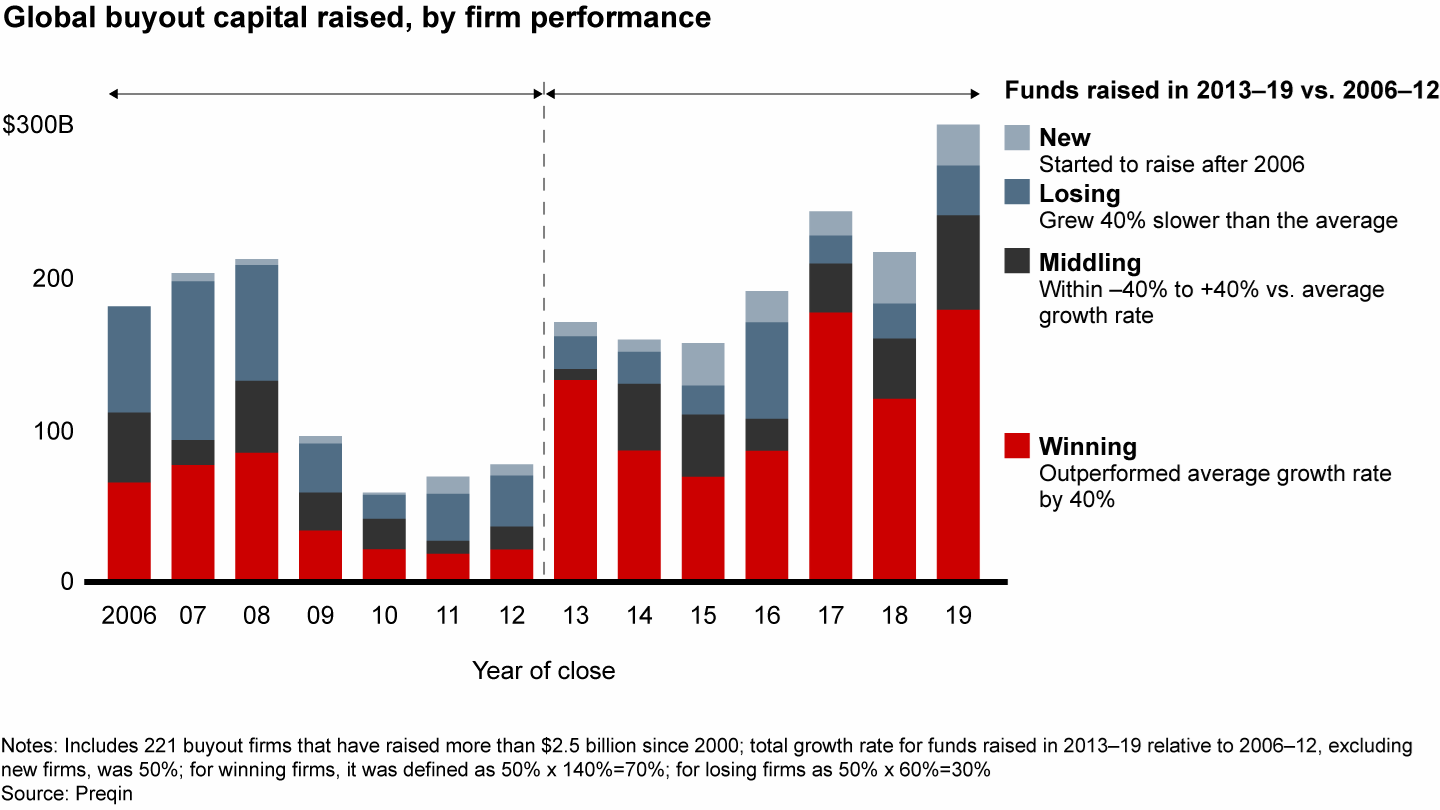
The contrast between the best and the rest is striking: Since 2006, the winners’ share of estimated buyout assets under management (AUM) grew by about 20 percentage points (see Figure 1.25). These outsize capital winners included Apollo, KKR, Platinum and Warburg Pincus.
Top-performing buyout firms’ share of capital has grown almost 20 points since 2006

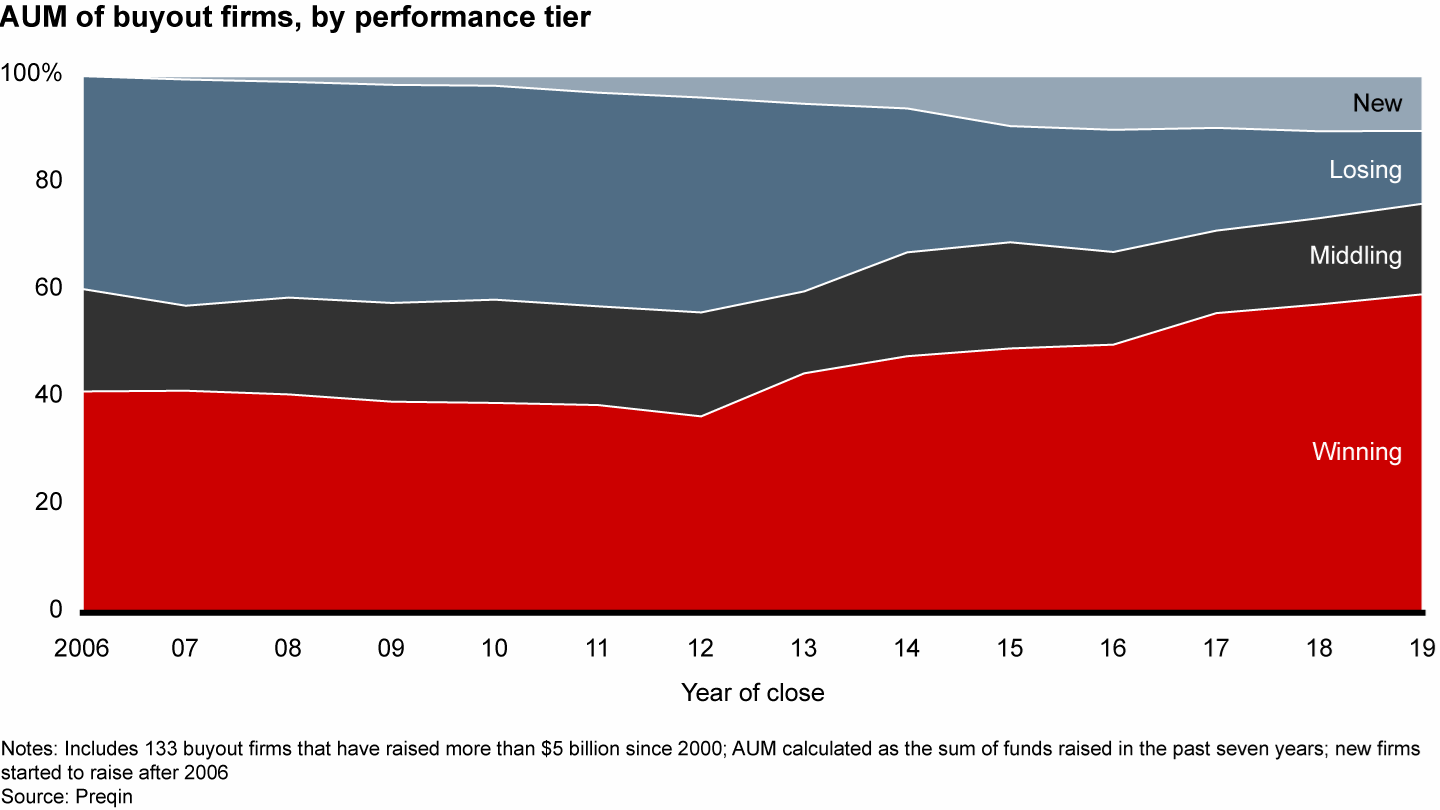
As LPs consolidated their positions, they wrote larger checks to fewer funds. In the trenches, this translated to a Darwinian fight for resources. Whereas the median time to close a fund from 2017 through 2019 was six months for winning firms, it took more than two years for underperforming firms. Winning firms could grow their successor funds by more than 50%, while laggards eked out an increase of less than 10%. Winners were also oversubscribed by 16%, twice the level of losing firms. The difference would be more pronounced if you consider the fact that losing firms often reduce their targets so that they can exceed them.
Who benefited most from this flight to quality? Although there were some notable successes among small PE firms, investors have increasingly favored larger firms (see Figure 1.26). Buyout firms with solid track records, a clear sector strategy and a distinctive value-creation story were clear winners, too. About 70% of winning firms had first- or second-quartile funds across 2007–14 vintages, vs. 22% for losing firms. And about a quarter of the winning firms focused on a single sector, twice the share of losing firms. Consumer- and tech-focused funds did particularly well in fund-raising (see Figure 1.27).
In fund-raising, larger PE firms benefited from the flight to quality

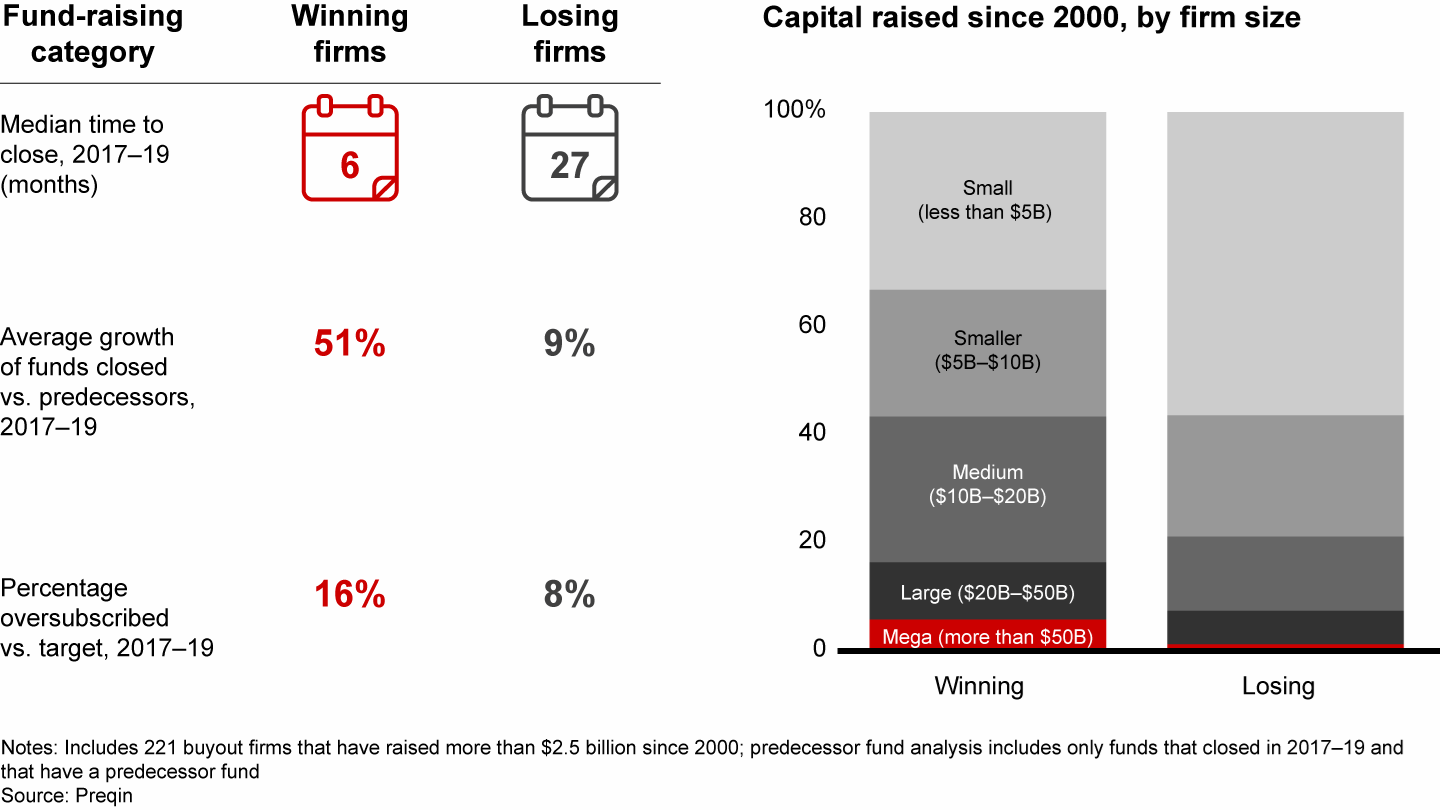
A solid track record and clear sector strategy matter in the bid to raise capital

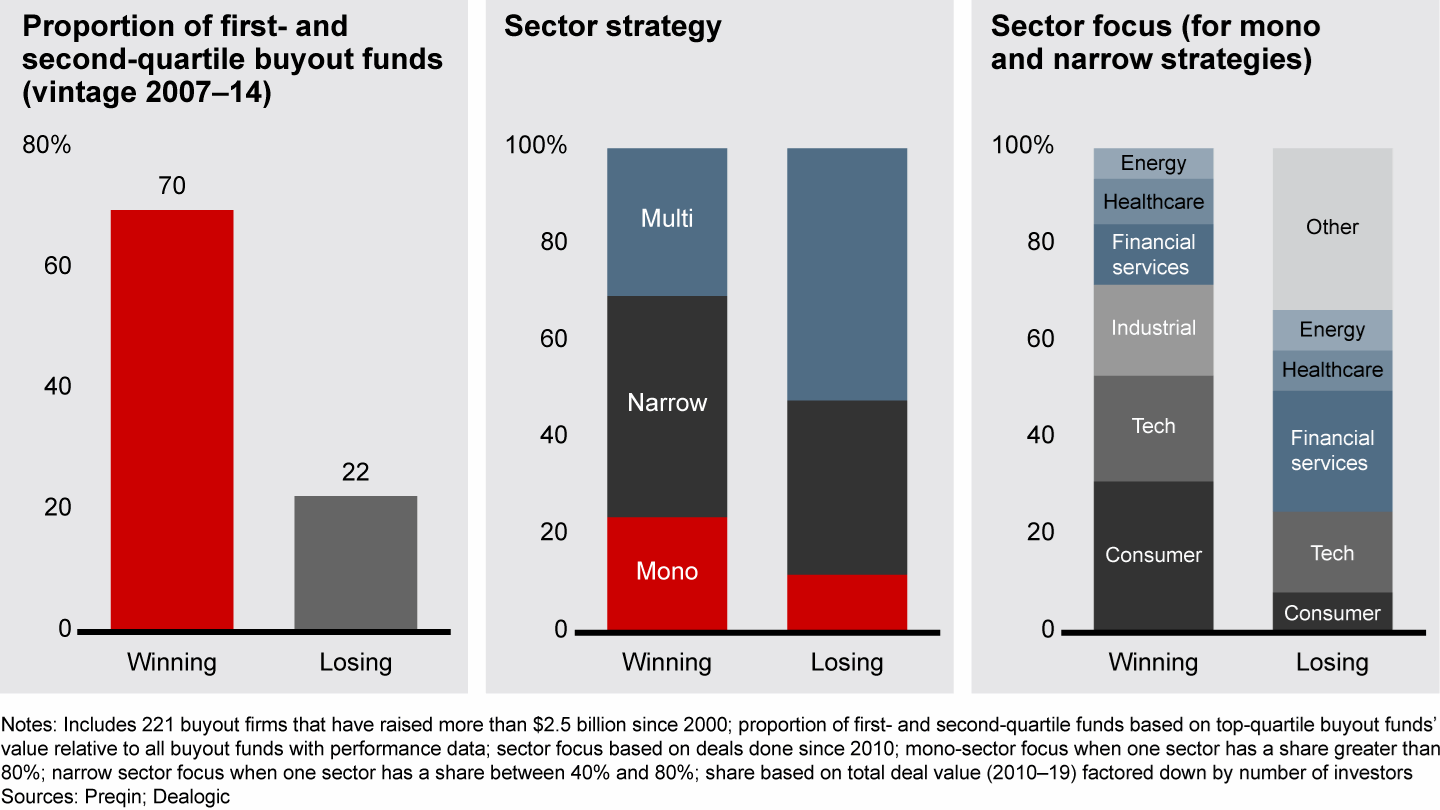
Still, the ranks of the winners in fund-raising are always in flux. Any PE fund could improve its standing over time. LPs have to strike a balance between limiting the volatility of capital calls (by diversifying their investments) and concentrating capital in top-performing funds.
For GPs, then, the most important task is to keep their current stable of LPs, which costs less and is easier than recruiting new LPs. Funds should also be alert for openings to expand their market share, such as a Chinese sovereign wealth fund increasing its allocation to private equity, or a US pension plan changing its CIO. In those cases, GPs need a pitch that differentiates their fund from others, and if their track record is merely average, they’ll need a convincing story about how the strategy has shifted.
Returns: As multiple expansion fades, new muscles required
Private equity still outperforms public equities. The asset class produces steadier, more reliable returns in all major regions, over several time horizons. However, returns of private and public equities have started to converge in the US.
A simple comparison with the S&P 500 Index indicates that, over a 10-year horizon, US buyouts did not produce much of a premium over the public market. One could argue this is not an apples-to-apples comparison. But even using more sophisticated benchmarks, the spread between public and private equity has narrowed in the US (see Figure 1.28).
Buyout funds have outperformed public equities in Europe and Asia-Pacific, but the spread has started to converge in the US

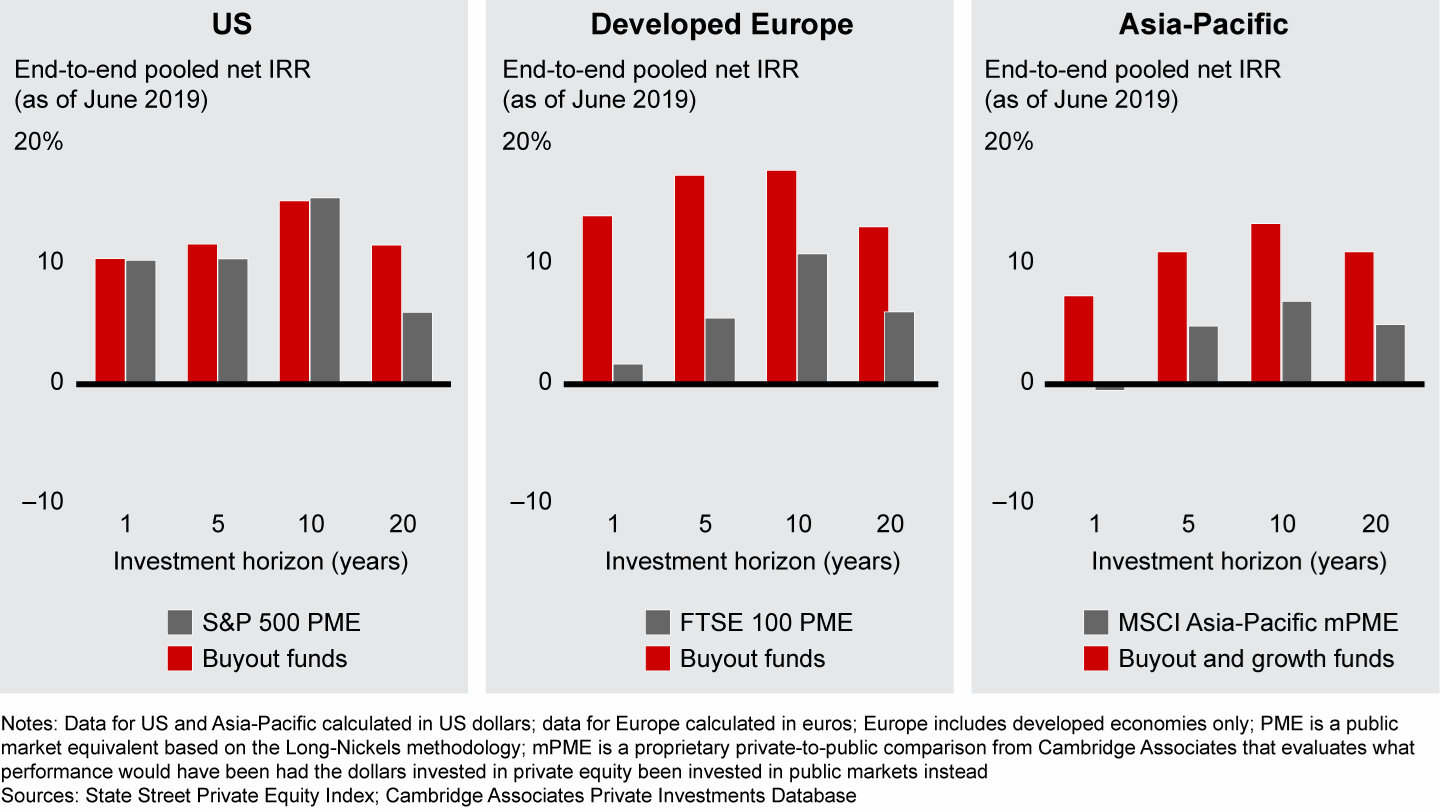
We explore the reasons for this convergence in Section 3. In short, private equity is maturing as an industry, and public stocks in the US have had a great run over the past decade. Nonetheless, the regularity of returns for the PE industry as a whole and the outperformance of first-quartile PE funds remain far superior. Moreover, some GPs have been able to sustain their performance.
Since 2010, EV/EBITDA multiple expansion has been the main driver of returns, surpassing revenue growth or margin expansion. Our analysis of CEPRES data for about 430 fully realized buyout deals completed between 2010 and 2019 in the US and Western Europe finds that growth in multiples led to nearly half of the increase in enterprise value (see Figure 1.29).
Since 2010, multiple expansion has been the main driver of buyout deal returns in the US and Western Europe

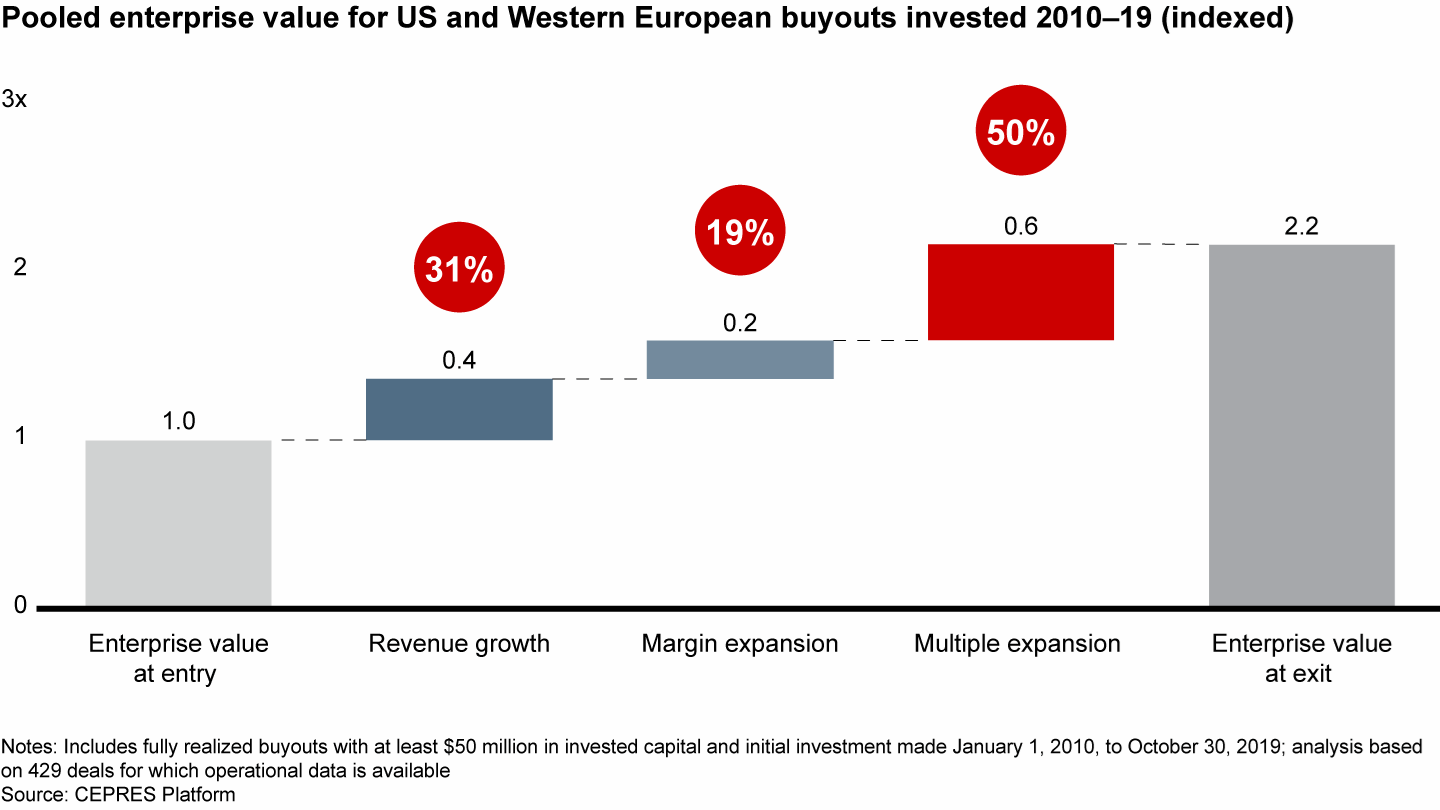
With multiples at record highs and macroeconomic conditions deteriorating, the spread between entry and exit multiples has likely plateaued and could start to diminish. Indeed, most GPs no longer include multiple expansion in their deal models (see Figure 1.30).
As multiple expansion slows, general partners need to build new muscles

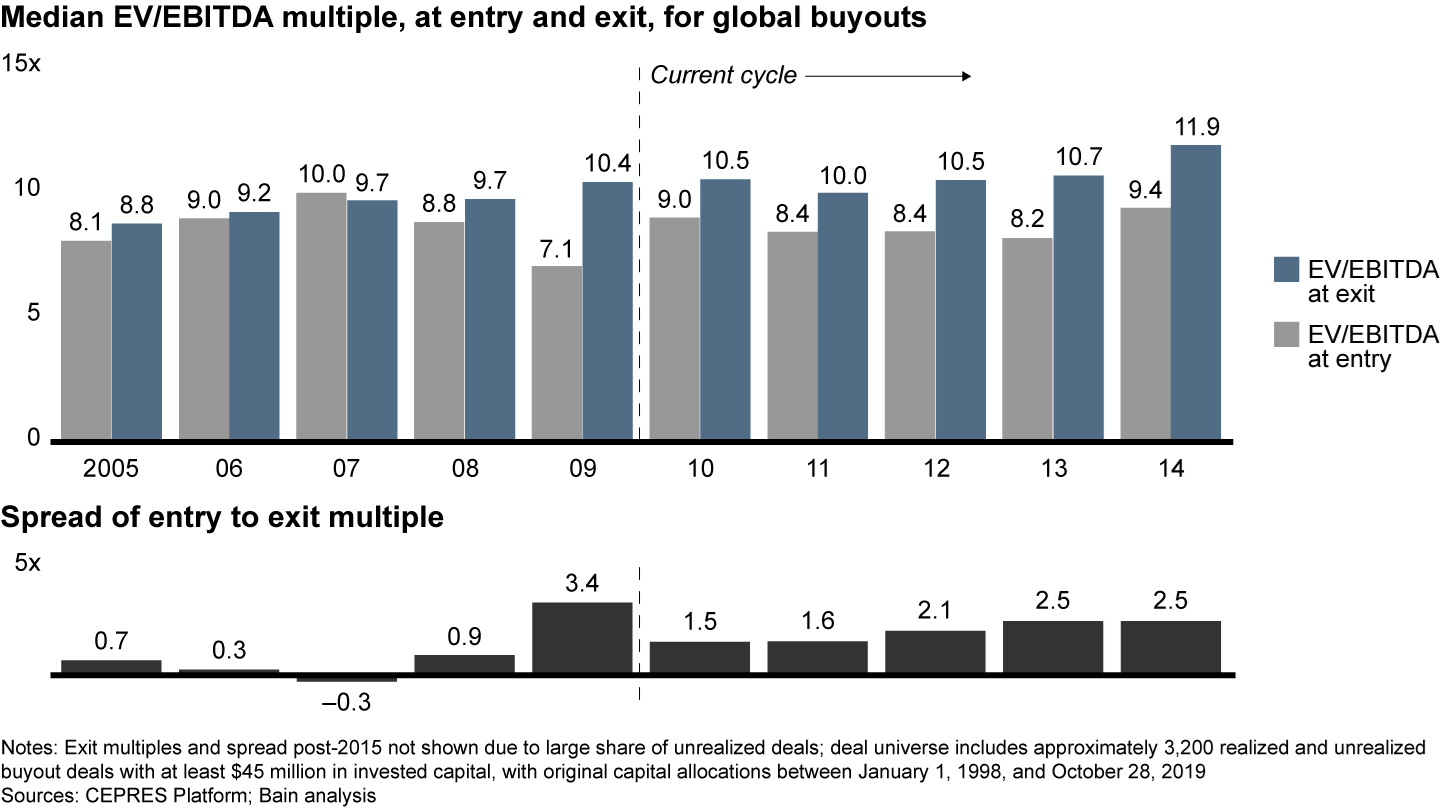
GPs thus must find new levers for value creation, whether that consists of pursuing M&A, stripping out costs, gaining market share, or entering new product lines or geographies. But building new muscles is easier said than done. When we analyzed 65 fully realized buyout deals invested in 2009 through 2015, the average margin was well below the deal model forecast, and the majority failed to meet their projected margin expansion (see Figure 1.31). Even more worrisome: For the deals where margin improvement was a critical factor in the value-creation plan, more than three-quarters did not meet the margin target.
Most PE firms are not achieving their projected margin expansion

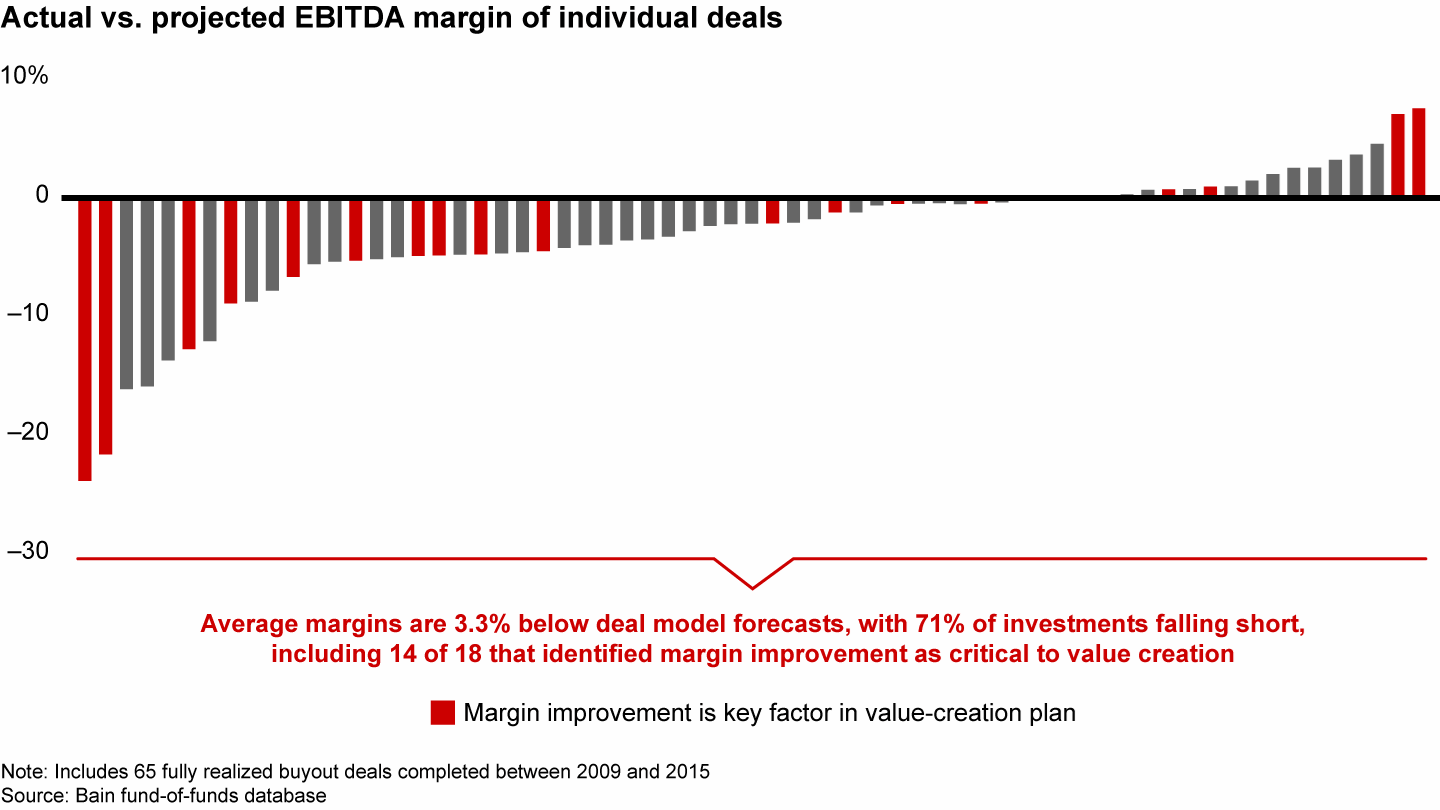
Buying on the cheap doesn’t necessarily solve the problems. As in previous years, plenty of GPs cite high prices as their top challenge to generating high returns. Yet new CEPRES data shows that assets selling for higher multiples tend to carry less risk and prove more resilient than lower-multiple assets (see Figure 1.32). They provide lower but less variable internal rates of return.
Assets selling for higher multiples provide lower but less variable returns

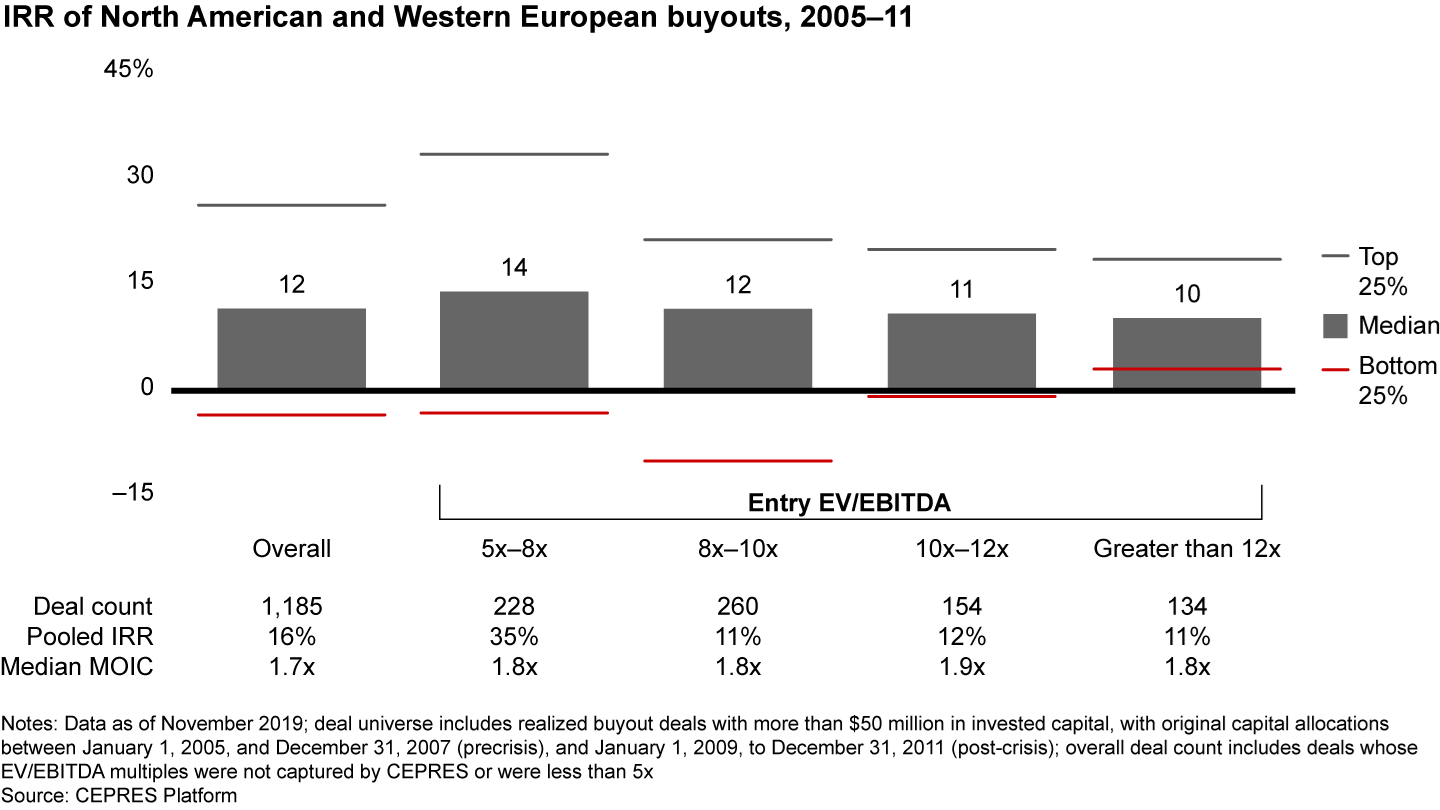
Consider two deal examples. On the cheap end of the spectrum, an industrial product manufacturer and distributor was acquired in 2012 for a multiple below 7x. But the company then faced intense competition from Chinese products and failed to turn around. The PE owner had to write it off in 2017.
By contrast, Permira bought the UK education technology firm Renaissance Learning in 2011 for $328 million, a multiple of 12x. Through a series of moves, including migration to a software-as-a-service (SaaS) business model, international expansion and divestment of noncore assets, Permira was able to sell Renaissance to Hellman & Friedman in 2014 for $1.1 billion, generating a return on investment of 4.1x for the firm.
* * *
Robust deal and exit activity, along with record-high fund-raising levels, produced another stellar year for private equity in 2019.
Risks abound, however. Valuations reached a new peak, fund-raising now has a winner-take-all dynamic and macroeconomic forecasts include a heightened risk of recession. Average returns are under pressure, so PE firms will need to step up their game if they want to land near the top of the heap.
Looking ahead, fund managers will continue to face a broad challenge: how to put record amounts of dry powder to work productively amid stiff competition for assets and worsening macro conditions. The most effective response is to get smarter about choosing targets, developing sector insights and doing due diligence. That will allow firms to identify new ways to create value.
In deal returns, individual lead managers—especially women—matter more than the PE firm
What drives persistence of returns in private equity? Two characteristics stand out in recent research by Oliver Gottschalg, a professor at HEC Paris and founder of the analytics firm PERACS.
First, persistence stems mostly from the individual who runs the deal, as opposed to the PE firm. Gottschalg analyzed about 1,250 deals for which manager information was available. Statistically controlling for other performance-relevant factors, he found the individual lead manager effect to be roughly twice as strong as the PE firm effect.
Second, gender diversity makes a material difference. Investments with women as the deal leader outperformed male-only deal teams by 12 percentage points on an internal rate of return (IRR) basis and by 0.52 times in terms of gross multiple of invested capital (MOIC).
Deals led by diverse teams also have failure rates (defined as gross MOIC less than 1) that are 8 percentage points lower than deals led only by men.
Gottschalg’s database included about 2,500 buyout deals completed by 50 GPs, with a 2015 cutoff date to avoid bias toward better-performing deals in more recent years. About 2% of the deals in the data set had women as leaders.
Explore the report
More from our 2020 Private Equity Report
Private Equity Report
This article is part of our 2020 Global Private Equity Report.